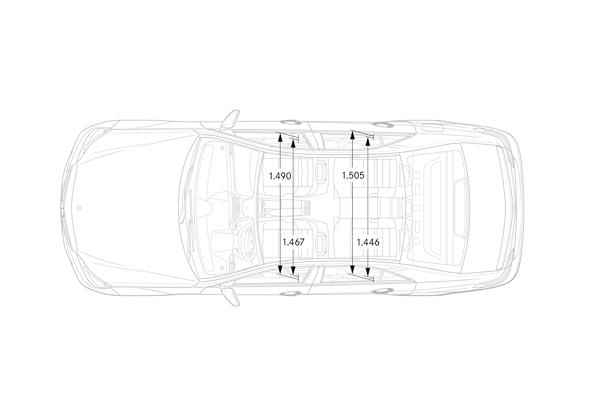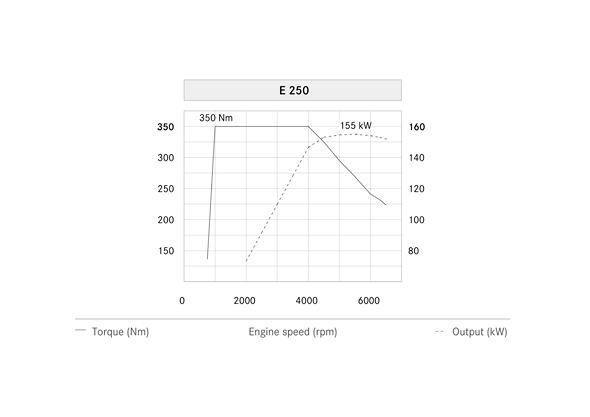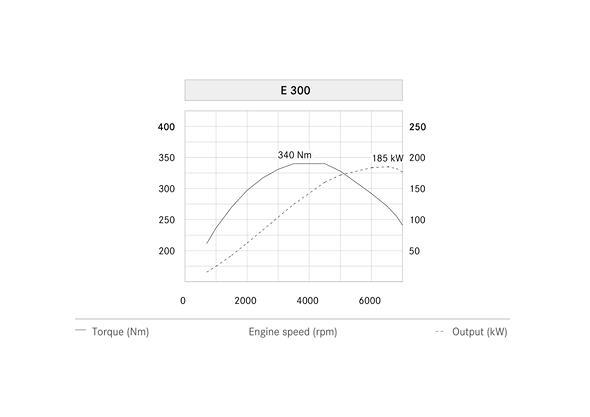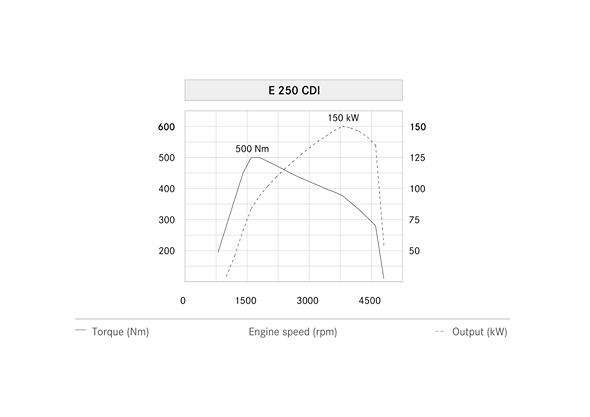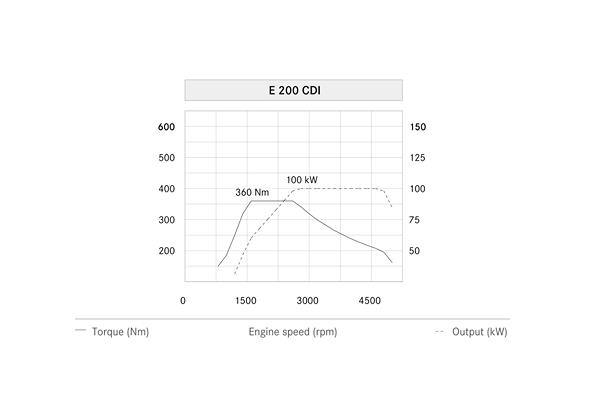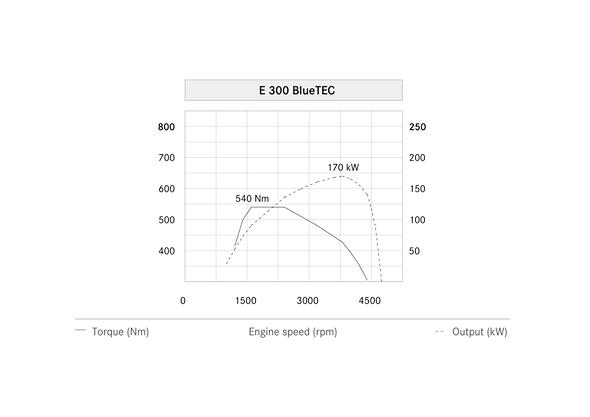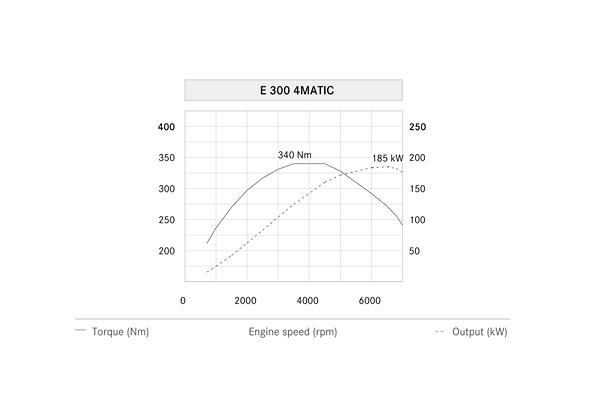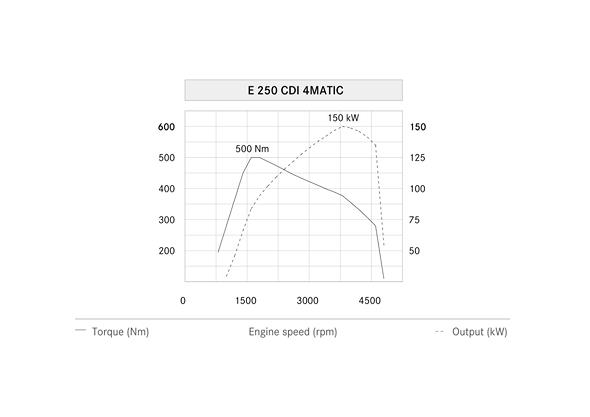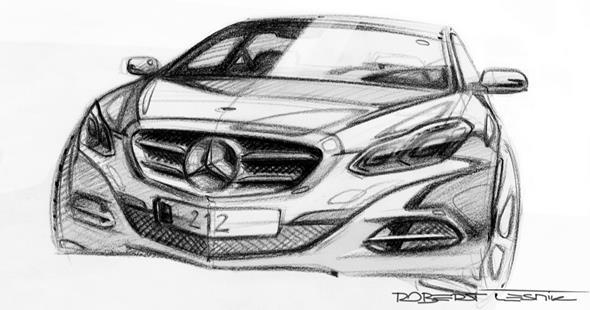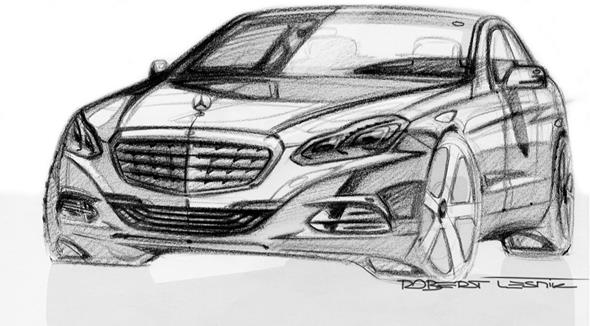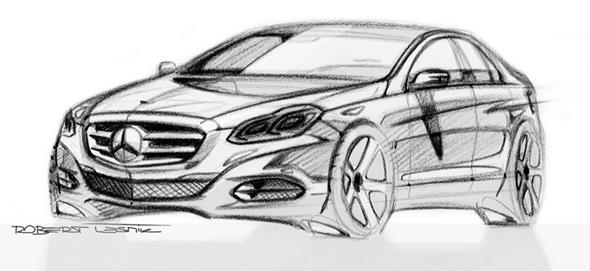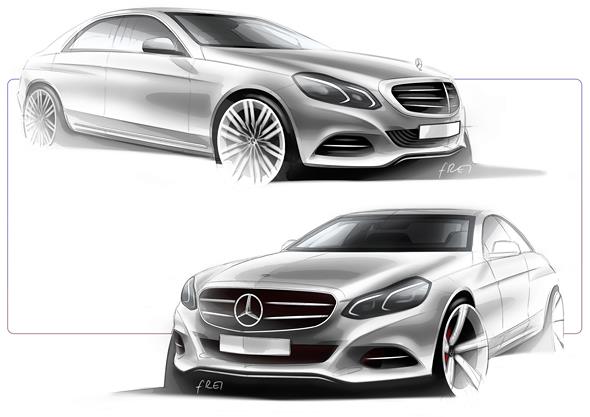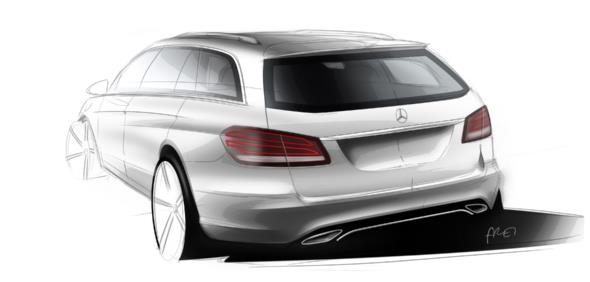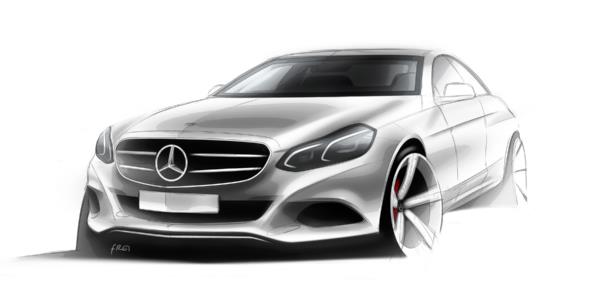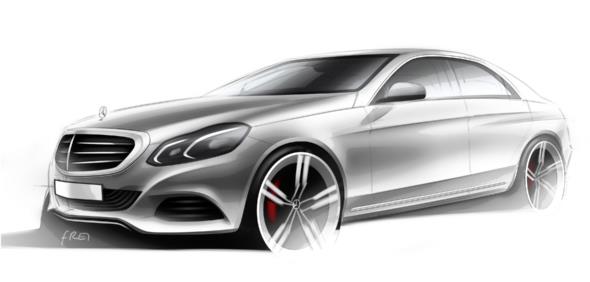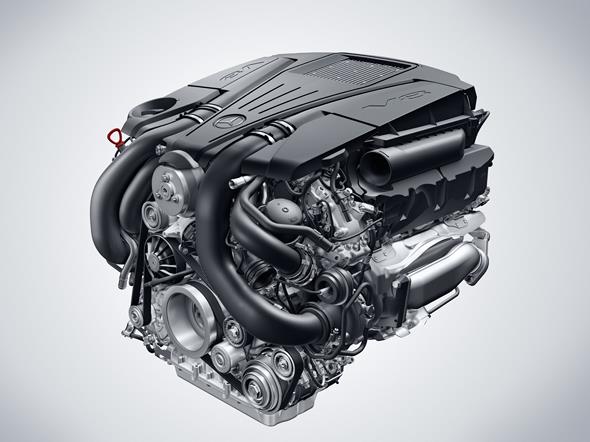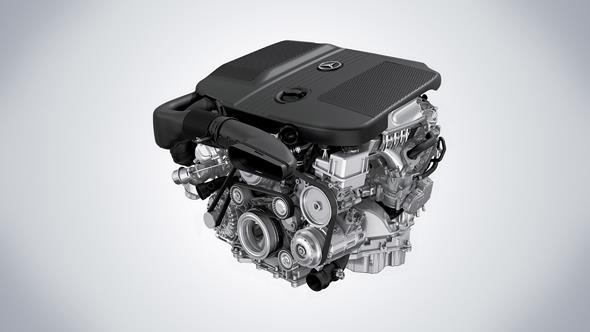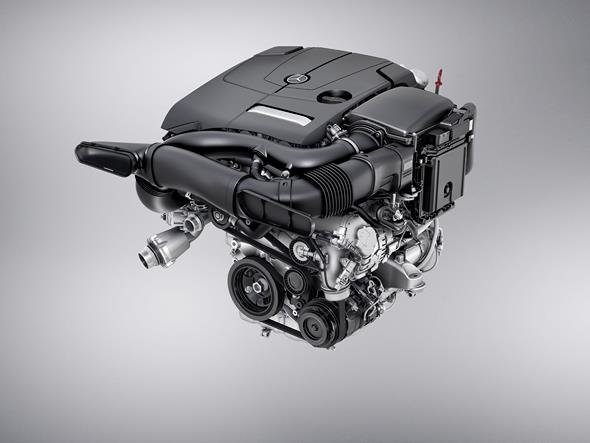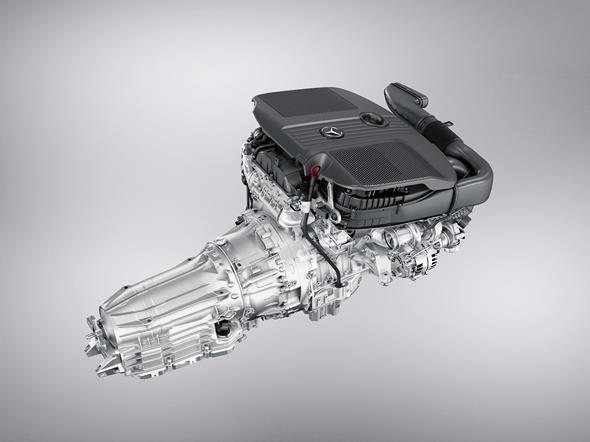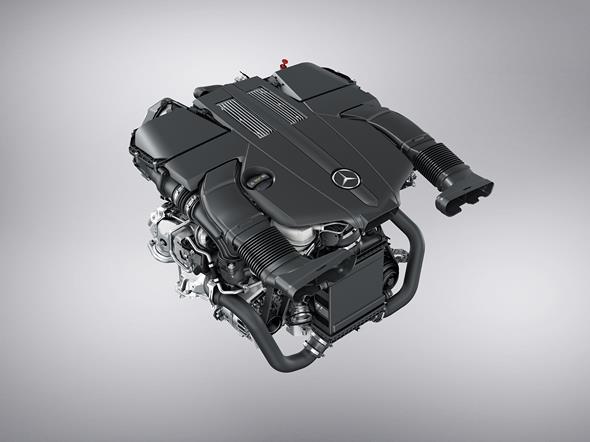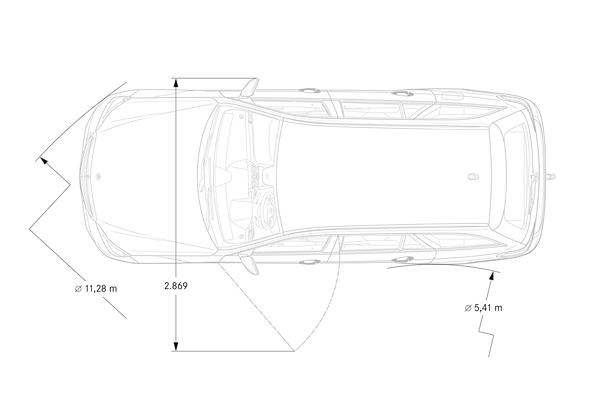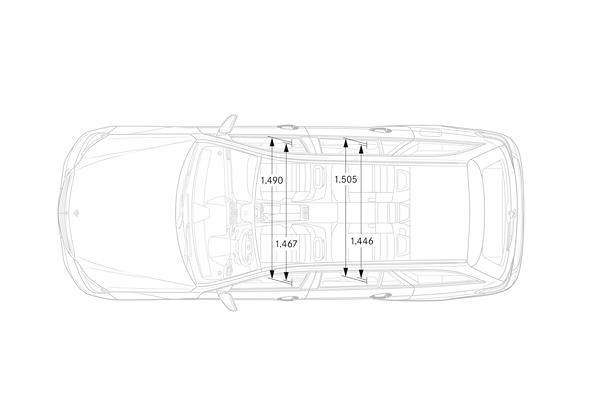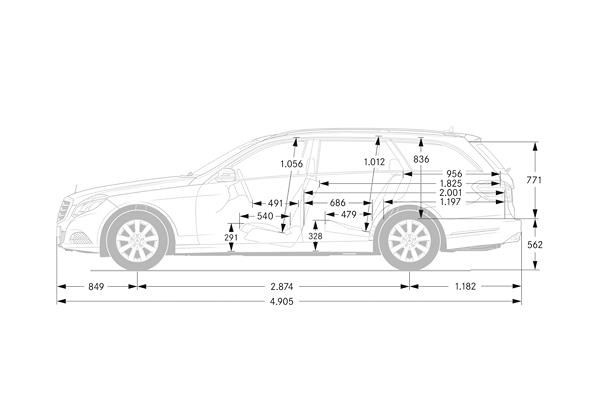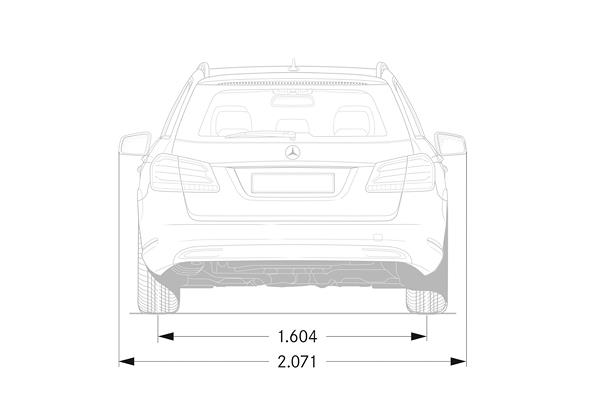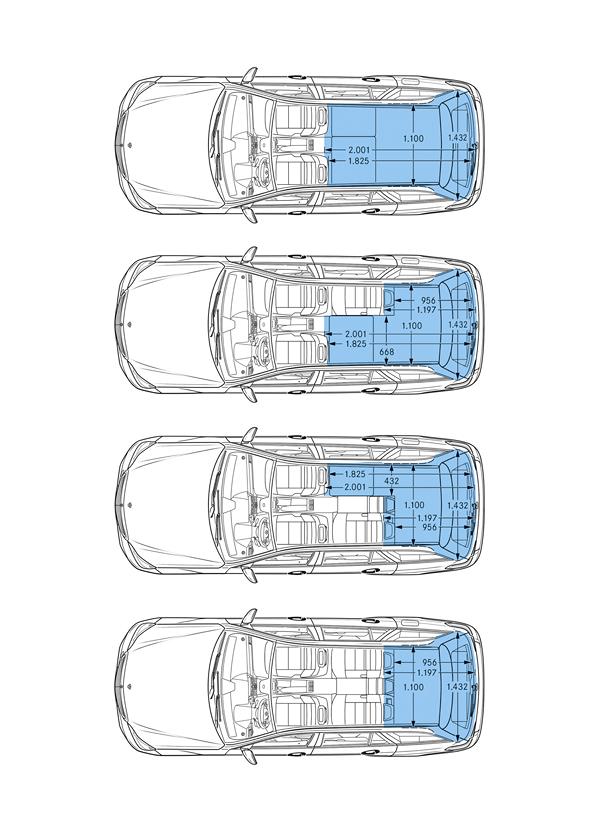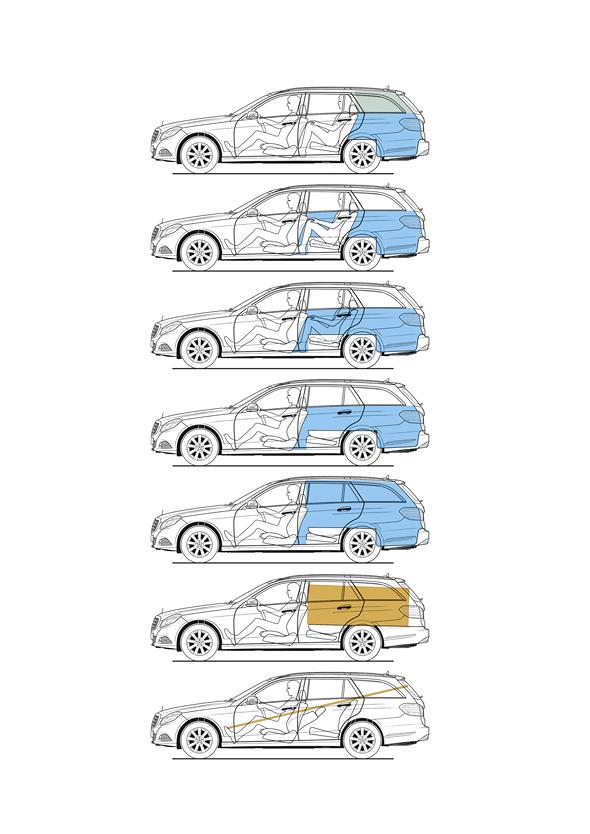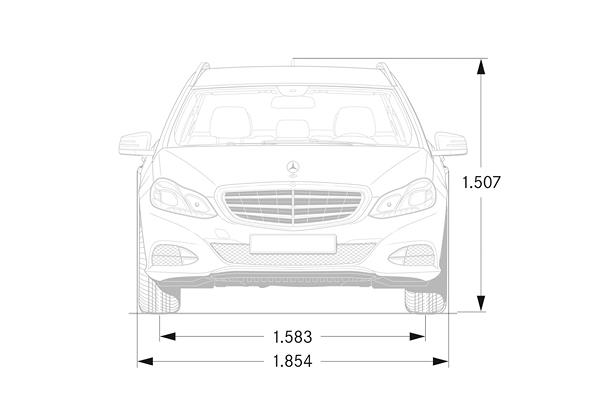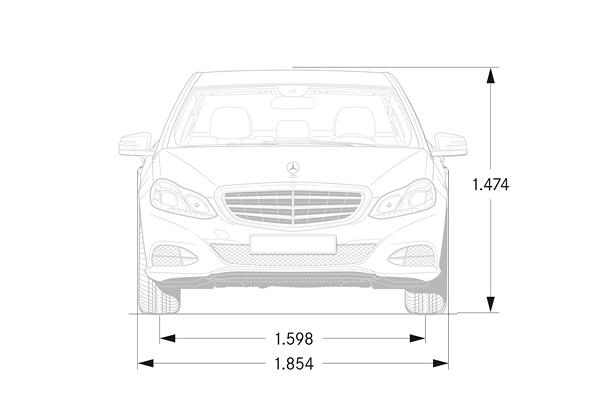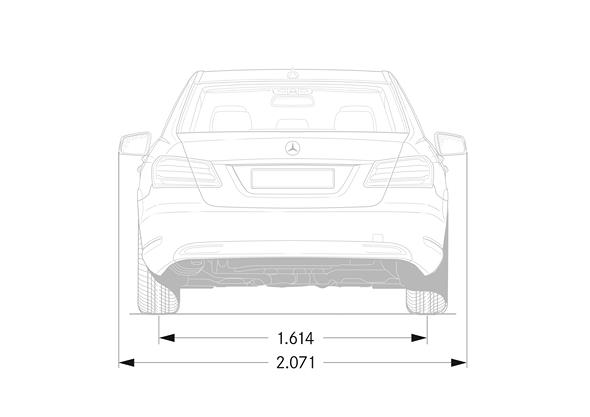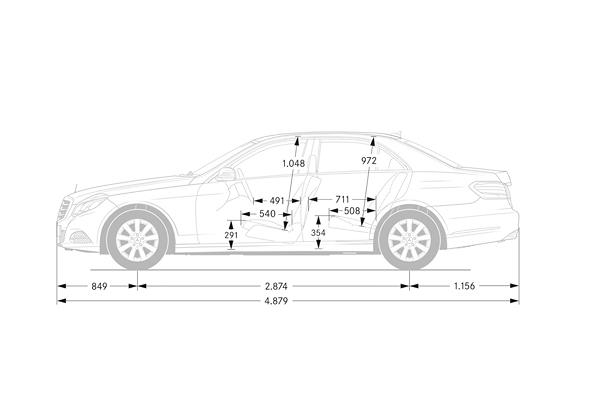The new Mercedes-Benz E-Class:


The new Mercedes-Benz E-Class: more efficiency, more intelligence, more emotional appeal
Mercedes-Benz has completely revised the Saloon and Estate models of the E-Class. As a result, the new E-Class has made a significant step forward when it comes to efficiency and ecology.
In both the Saloon and Estate models, new or optimised assistance systems from the future S-Class are celebrating their world premiere. This powerful development boost is reflected to exciting effect in the design of the E-Class.
This comes courtesy of new, powerful BlueDIRECT four-cylinder petrol engines featuring sophisticated direct injection technology, a new, efficient six-cylinder engine as well as even more economical diesel engines.
With a new front, new bumpers, and revised side view, it encapsulates efficiency, intelligence and emotional appeal in a visually superior manner. In this way the E-Class is securing its leading position in the luxury class vehicle sector at the very highest level: dynamically elegant, it combines intelligent technology with superior style.
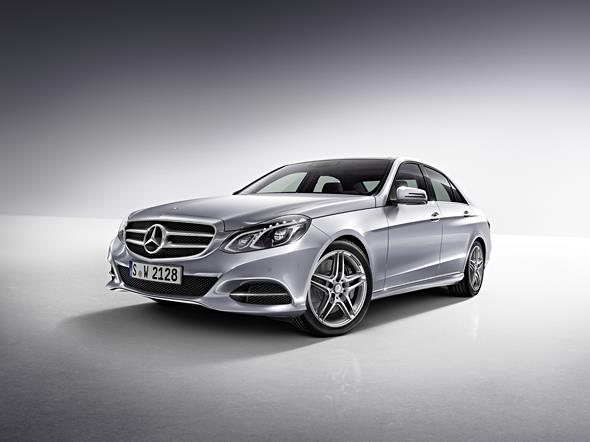
The Saloon and Estate are continuing the success story of the E-Class. More than 600,000 examples of the current E-Class Saloon model series have been sold worldwide, and no fewer than 100,000 customers have already opted for the latest version of the Estate.
The models of the E-Class are therefore making a significant contribution to the growth of Mercedes-Benz, and are setting clear standards in the areas of safety, design, quality and efficiency.
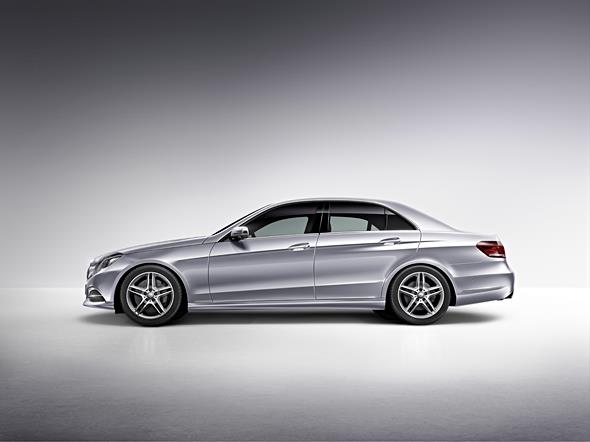
Radiator variants – classic or sporty
For the first time, the E-Class is available with two different front ends: the basic variant and ELEGANCE equipment line come with the classic, three-dimensional Saloon grille with 3-louvre look and Mercedes-Benz star on the bonnet.
The AVANTGARDE equipment line, on the other hand, incorporates the sporty front end with central star, and as such boasts an independent, front-end look with a sporty emphasis.
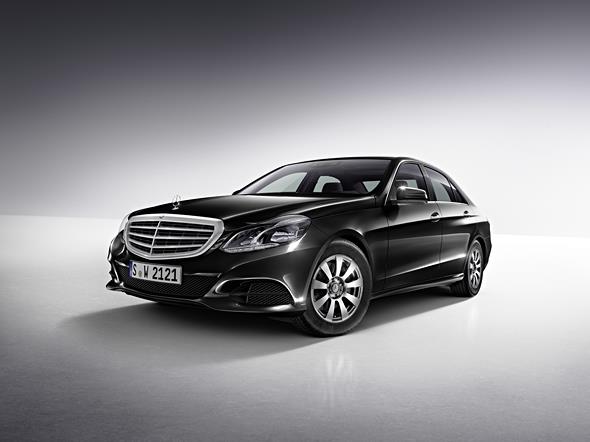
The headlamps have been redesigned and comprise all functional elements with a single headlamp lens. The low-beam headlamps and the daytime running lamps feature LED technology as standard. Full LED headlamps are also available as an option for the first time in this class.
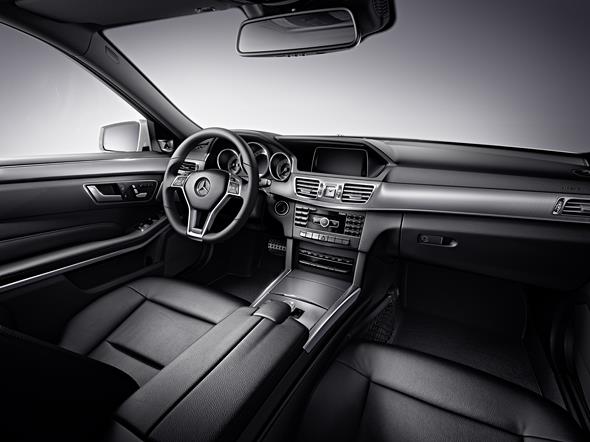
A modified side view with new feature line and repositioned trim strip make both the Saloon and the Estate appear longer. Overall the E-Class not only looks more elongated, but also more elegant yet at the same time dynamic.
High-tech engines: efficiency meets performance
Both the E-Class Saloon and Estate are available with a broad range of powerful and efficient petrol and diesel engines – all fitted with ECO start/stop function. New units include the BlueDIRECT four-cylinder petrol engines in the E 200 and E 250, featuring the same sophisticated technology used in the latest six-cylinder engine from Mercedes-Benz.
Both of the four-cylinder petrol engines meet the future EU6 standard, while the E 250 even complies with the strict criteria of efficiency class A.
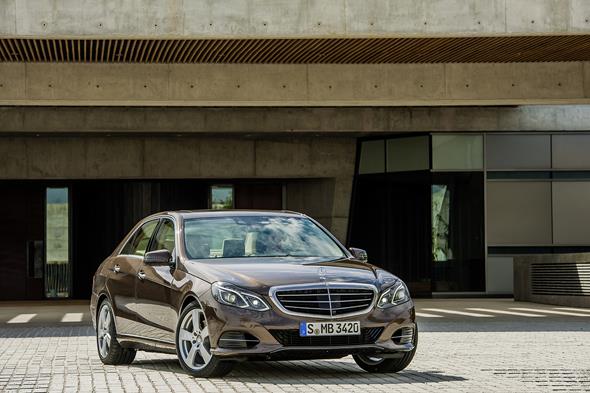
The six-cylinder petrol engines in the E 300 and E 400 are also state-of-the-art – and for the first time feature a biturbo drive. The same advanced engine technology enables the V8 in the E 500 to achieve outstanding levels of performance and efficiency.
The four cylinder diesel engines in the E 200 CDI, E 220 CDI and E 250 CDI, well known for their efficiency and featuring the latest injection technology, are now even more economical, thanks among other things to a revised drive train. This is also the case for the E 300 BlueTEC HYBRID, currently the most economical luxury-class saloon, which in addition to the four-cylinder diesel engine also has a 20 kW (27 hp) electric motor under the bonnet.
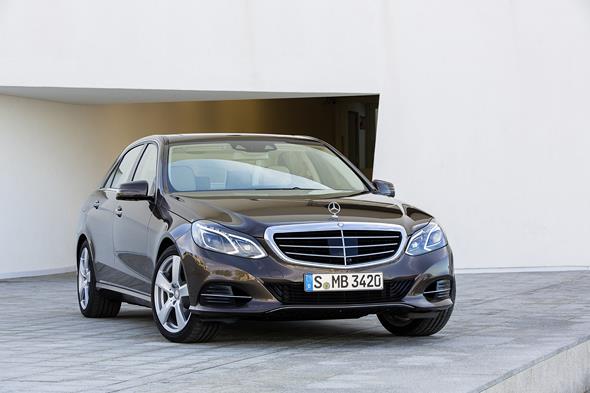
The V6 diesel engines in the E 300 BlueTEC and E 350 BlueTEC have been revised and fitted with environmentally friendly and efficient BlueTEC technology, such that they currently already meet the future EU6 emissions standard. Virtually all of the E-Class models with diesel engines fall into efficiency class A, while the E 300 BlueTEC HYBRID is even classified in efficiency class A+.
Intelligent assistance systems
In the main markets, both the Saloon and Estate models are fitted as standard with COLLISION PREVENTION ASSIST, a radar-based collision warning system with adaptive brake assist systems. Also forming part of the standard equipment is ATTENTION ASSIST, which is now able to warn of inattentiveness and drowsiness across a wider speed range, and also inform the driver about his level of fatigue and the amount of driving time which has elapsed since the last break.
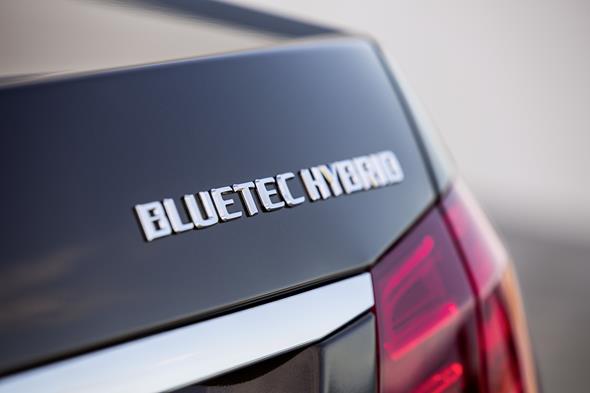
In addition, also optionally available in the new E-Class are a number of additional assistance systems which are mostly new or now feature significantly extended functions.
Quotes on the new E-Class
Dr Dieter Zetsche, Chairman of the Board of Management of Daimler AG and Head of Mercedes-Benz Cars: “Globally we have already sold over eleven million E-Class Saloon models, and more than a million E-Class Estate models. And with the new E-Class we will continue to build on this success as it is ideally placed to enable us to do so. It features exemplary efficiency and environmental compatibility. It allows us to offer a petrol model for the first time in this segment which falls into efficiency class A, something which virtually all of the diesel models also achieve. In addition, the new E-Class offers some unique assistance systems which are helping to bring the vision of accident-free motoring closer to reality. We are also honouring the claim made by Gottlieb Daimler with the new E-Class: the best or nothing.”
Dr Joachim Schmidt, Executive Vice President Mercedes-Benz Cars, Sales and Marketing: “With the new E-Class we are setting down clear markers in the areas of safety, design and efficiency. It brings lots of technical innovations to the road and is without doubt the best E-Class ever. This is also reflected in its design and lovingly revised interior. As a result, in visual terms it brings a breath of fresh air to the luxury class. The “E” therefore continues to stand for the leading position in this demanding segment.”
Professor Dr Thomas Weber, Member of the Board of Management of Daimler AG, responsible for Group Research and Mercedes-Benz Cars Development: “The new E-Class represents a major step forward in every respect. The design elicits plenty of emotion, causing a stir in its segment. Its technical highlights are unique. For example, new and improved assistance systems from the upcoming S-Class take the burden off the driver by automatically keeping the vehicle in its lane and also tracking traffic in tailbacks. For the first time, there are also systems that can prevent accidents involving crossing traffic or pedestrians. What is more, with its new engines the E-Class achieves optimum values in terms of efficiency, offers an infotainment system with internet, and boosts safety when driving at night thanks to advanced LED headlamps and permanent high-beam with no dazzling. The E-Class is a high-tech package – and a very attractively
packaged one at that.”
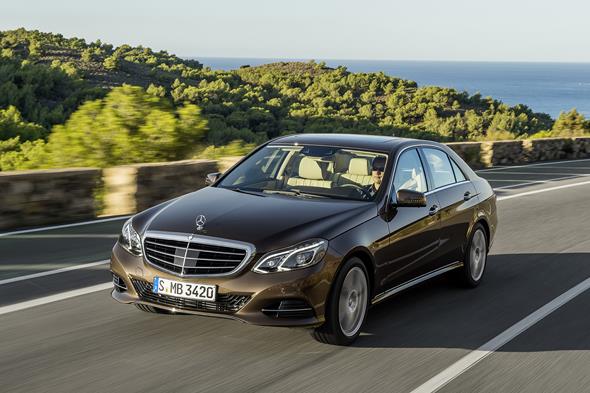
Design
Stylish, refined, sporty
As part of the facelift, Mercedes-Benz has sharpened the overall appearance of the E-Class. Intelligent modifications to the design have given the E-Class a new front end and created new, exciting proportions. The modifications have implemented the new Mercedes-Benz design idiom consistently, and reinterpreted the classical design values of the brand using the existing basis. The result is a superior and refined appearance which is still sporty and emotionally appealing.
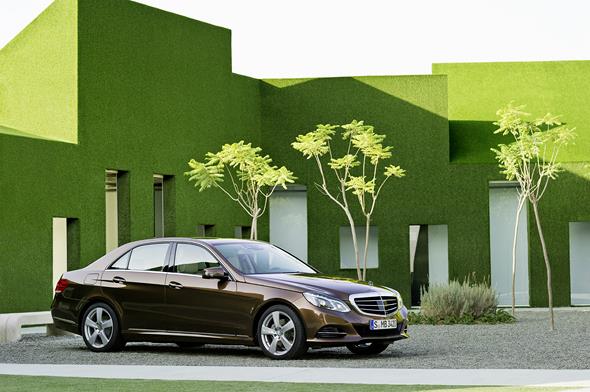
The headlamps have been redesigned and comprise all functional elements with a single headlamp lens. Flowing light elements within the headlamps help to ensure that the “four-eyed” look which is typical of the E-Class has been graphically retained, and afford both the Saloon and the Estate an unmistakable night design. The low-beam headlamps and the daytime running lamps feature LED technology as standard. Full LED headlamps are also available as an option for the first time in this class.
Design: two new front ends to choose from
For the first time, the E-Class is available with two different front ends: the basic variant and ELEGANCE equipment line come with the classic, three-dimensional Saloon grille with 3-louvre look and Mercedes-Benz star on the bonnet.
The AVANTGARDE equipment line, on the other hand, incorporates the sporty front end with central star and twin louvre which is softly shaped around the star recess, and as such boasts an independent, front-end look with a sporty emphasis.
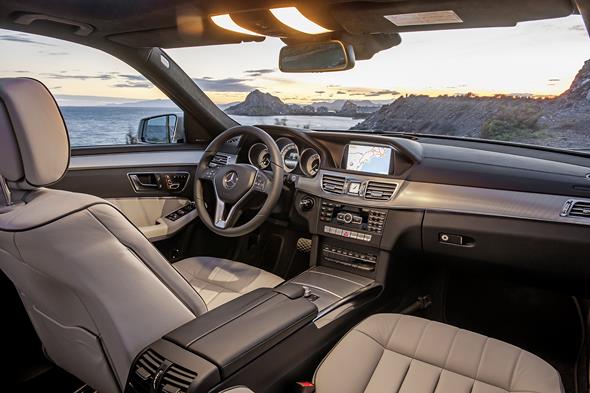
The swept-back bonnet and front bumper have also been redesigned. With its flowing lines, the bonnet follows the new design idiom in a sleek and very straightforward manner. Its contours merge elegantly and smoothly into the frame surrounding the radiator trim and the headlamps.

The newly shaped bumper, which is now free of all light functions, presents an exciting shift between differently curved areas with precisely executed contour lines and soft shapes. It has a modern appearance and with the wing design of its curved spoiler lip subtly underscores the sporty aspirations of the E-Class.
The faces of the new E-Class
| Standard equipment | ELEGANCE | AVANTGARDE | |
| Model | Radiator grille | Radiator grille | Sporty front |
| Mercedes star | on the bonnet | on the bonnet | Central star |
| Headlamps | Partial LED headlamps | Partial LED headlamps | Partial LED headlamps |
| Bumper, wing | Black | High-gloss silver | High-gloss silver |
| Radiator louvres/grille | High-gloss greylouvres | High-gloss blacklouvres | Matt silver louvres,blackdiamond grille |
| Grille in the cooling air intakes in the bumper | diamond-shaped | louvre-shaped, parallel to theopening contour | diamond-shaped |
A new line visually stretches the E-Class
From the side, the new E-Class appears visibly stretched. This comes courtesy of a redesigned line which starts on the rear door and runs dynamically beneath the structure line through to the tail light. In this way it visually underscores the structure line with its typical “undercut”. The redesigned side view visually benefits the vehicle in terms of length, and also makes it look broader when viewed from the rear. The new line is a stylistic feature of the new design idiom, which is based on beautifully stretched, voluminous shapes with convex/concave areas, accentuated by sharp lines.
The three-dimensional side trim has been repositioned and moved downwards. As a result, the greenhouse appears flatter, despite the window areas remaining unchanged. This has given rise to visually new, more dynamic proportions.
The same intelligent design modifications have also given the Estate a more superior and more dynamic appearance. Here, elegant, chrome-plated roof rails provide an exciting line. The roof rails are chrome-plated in all design and equipment lines, while the mounting hardware is finished in black. Concealed B and C-pillars featuring “frame under glass” and a steep D-pillar tapering downwards characterise the closed look of the Estate model’s greenhouse.
Broad, distinctive rear end
At the rear, the lights and bumper have been revised. The new horizontally structured LED tail lights with new two-tone look (divided into ¾ red and ¼ white) emphasise the width, and with fibre optics create a characteristic night design which is typical of Mercedes. A third brake light – integrated into the tailgate spoiler above the rear window in the case of the Estate – as well as the number plate illumination, also make use of LED technology.
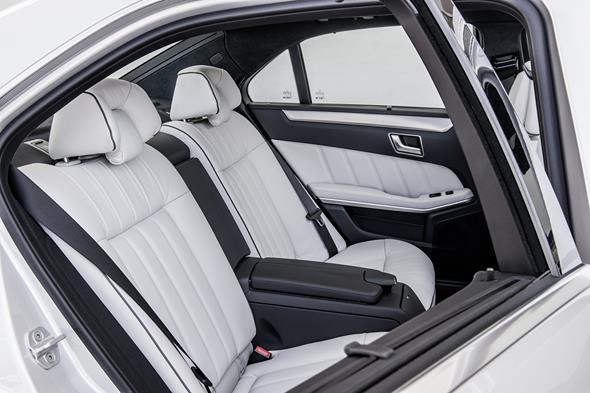
In the Estate, thanks to the steeply angled, narrow D-pillar, a large, broad tailgate provides for a large loading aperture and therefore ease of loading and good usability of the luggage compartment.
The new rear bumper captures the new design idiom and brings it to a consistent conclusion with a wing attachment which appears to float. Depending on the engine, the tailpipes are concealed out of sight or are highlighted to the onlooker. The eight-cylinder models as well as the AVANTGARDE line feature rectangular tailpipe trim integrated into the bumper.
This is also the case for the optional Exterior Sports package as well as the AMG Sports package.
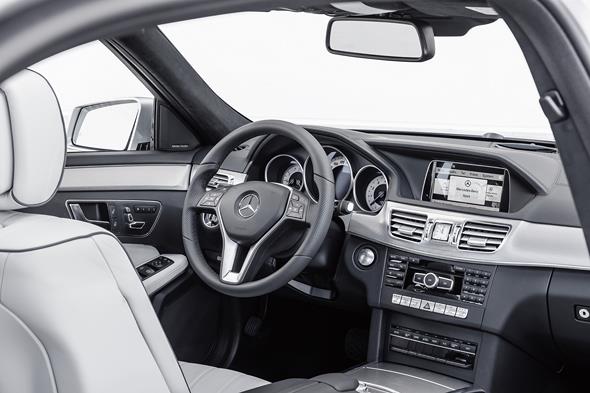
E-Class owners can also apply some individual visual highlights with an attractive range of new wheels. The base variant comes with wheels measuring 40.6 cm (16 inches), while the ELEGANCE and AVANTGARDE lines are fitted with 43.2 cm (17-inch) wheels.
In conjunction with the Exterior Sports package, wheels measuring 45.7 cm (18 inches) are fitted, and the variant with the AMG Sports package comes with AMG light-alloy wheels measuring 45.7 cm (18 inches). As an option, wheels with a 48.3 cm (19-inch) diameter are also available.
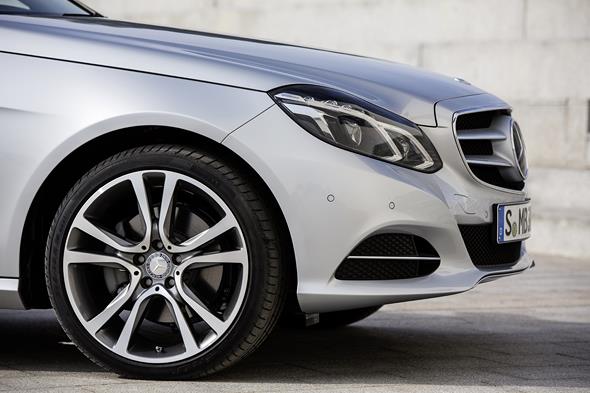
The elegantly dynamic style is also highlighted with some new colours: covelline blue, dolomite brown and hyacinth red are new additions to the
range of paint finishes.
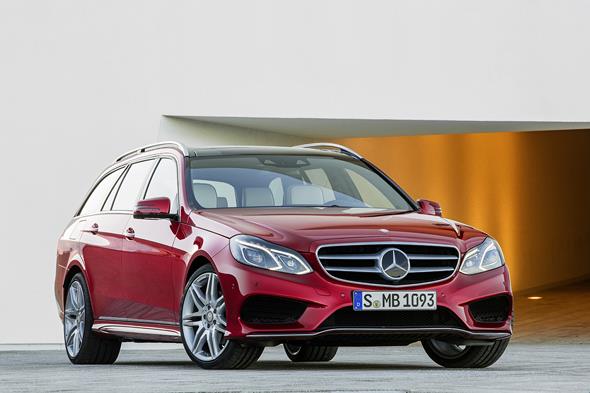
Interior
Exclusive style, high-quality materials
Mercedes-Benz has carefully revised the interior of the E-Class in such a way that, together with the expressive, modern exterior, it forms a harmonious unit.
The new, two-part trim on the dashboard is what first catches the eye: it stretches across the entire width of the interior and as such visually underscores the generous sense of space. It is bordered by a high-quality silver chrome frame and, in conjunction with all of the high-quality materials available for the trim, creates a consistent overall look.
Choices available include fine woods (high-gloss light brown burr walnut, open-pore brown ash) or a new aluminium variant with textured grain. All of the materials can be freely selected, irrespective of the equipment line.
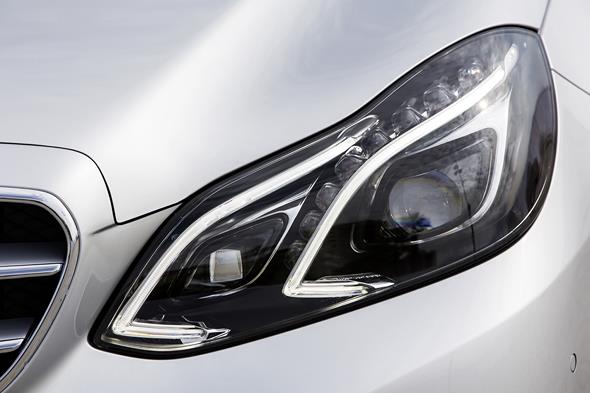
Other eye-catching elements include the instrument cluster and high-gloss framed central display. In the standard and ELEGANCE line models, the instrument cluster features black backplates, while the AVANTGARDE line models have silver backplates.
A new design for the air vents, an analogue clock between the two central air vents as well as redesigned controls beneath the head unit all serve to highlight the overall high-quality feel of the interior of the new E-Class. Precise joints and carefully defined curves also make a contribution in this respect too.
An enhanced sense of perceived quality also comes courtesy of the surfaces in the interior of the new E-Class. In all equipment variants they feature a fine grain which boasts a high-quality look and feel and is not only elegant to look at but also easy to clean. As an option, the dashboard and beltline can also be finished in ARTICO man-made leather.
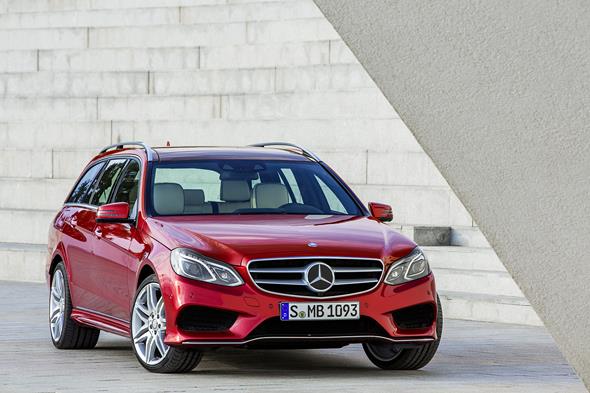
Contributing to the harmonious and at the same time functional appeal of the interior is the redesigned centre console. In conjunction with the automatic transmission, besides the controller for the infotainment system there is also no longer a selector lever positioned here.
Instead, the automatic transmission is operated via the DIRECT SELECT lever and shift paddles on the new multifunction steering wheel. In the horizontal part of the centre console there is therefore plenty of space for stowage facilities. The controls are clearly arranged and generously designed in silver chrome.
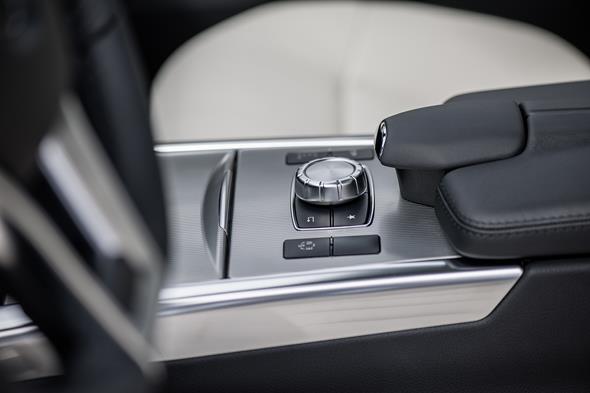
- Depending on the line and equipment, drivers have a choice of four variants of the multifunction steering wheel: the standard and ELEGANCE line models feature a 4-spoke multifunction steering wheel, finished in nappa leather with two silver-chrome inserts
- The AVANTGARDE line provides a sporty three-spoke multifunction steering wheel as standard, finished in nappa leather with perforated inserts and thumbrests, twelve trapezoid buttons and two silver-chrome inserts on the lower spoke
- The AMG Sports package includes a 3-spoke AMG sports steering wheel finished in nappa leather with perforated inserts and thumb-rests, flattened bottom section and twelve trapezoid buttons as well as two silver-chrome inserts on the lower spoke
- In conjunction with the Exclusive package, the new E-Class is fitted with a wood/leather multifunction steering wheel, which can also be ordered as an optional extra for other model variants
The steering column benefits from an extended, generous adjustment range. It can be individually positioned by plus/minus 25 mm in terms of height, as well as 15 mm forwards and 35 mm backwards in terms of length.

Colourful highlights
The new interior colours “silk beige”, “espresso brown”, “crystal grey” and “porcelain” provide a whole host of individual, modern design options for the interior in the colour combinations crystal grey/black, reef grey/crystal grey, silk beige/espresso brown, silk beige/black or porcelain/black. An additional strikingly colourful highlight is also offered by the ambient lighting for the ELEGANCE and AVANTGARDE lines. Its colour tone can be set individually based on three variants – neutral, solar and polar. The standard version comes with single-tone ambient lighting.
The colour of the door linings is matched to the interior, and two different materials are available for the linings:
- ARTICO man-made leather is used in the case of the appointment variants fabric, fabric in combination with ARTICO man-made-leather, and also in conjunction with leather appointments with vertical topstitching
- nappa leather with vertical topstitching is combined with appointments in nappa leather
Additional design features of the door linings include:
- generously sized trim element beneath the beltline, which is finished at the top with trim in silver chrome
- door opener in silver chrome, as well as silver-chrome surround for the controls for electric seat adjustment, in conjunction with the Memory package
- armrest with silver-chrome trim, the shape of which underscores the sweeping lines of the armrest
- door pocket with large stowage space
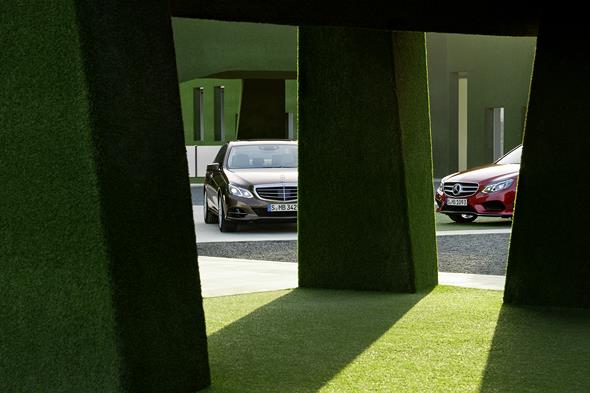
Attractive, ergonomic seats
The seats of the new E-Cass each feature a different look, depending on the material used:
- seats in fabric and ARTICO man-made leather have transverse piping
- seats in leather and nappa leather have longitudinal piping
In both cases, the padded piping not only fulfils a number of ergonomic requirements but at the same time its contouring helps to enhance the high-class appeal. The taut bolsters on the armrests and seat cushions help to ensure secure lateral support.
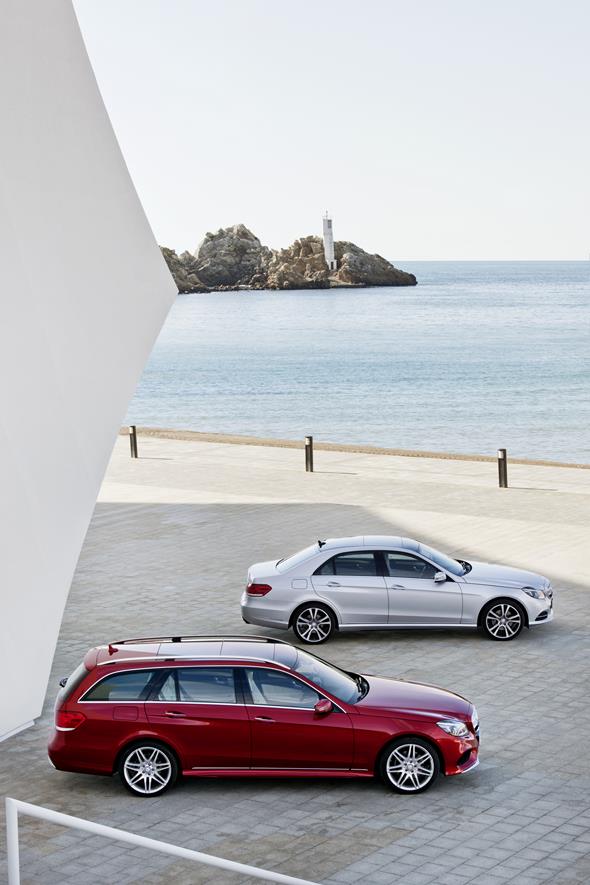
The driver’s seat and front passenger seat can be electrically adjusted for height, backrest angle and seat cushion angle.
As an alternative to the ergonomically conceived and stylishly designed standard appointments, the following seat variants are also available as an option and offer additional functions as well as even higher levels of comfort:
- the Multicontour Seat package for driver and front passenger provides even more individual adjustment options and is recommended by the AGR, or “Aktion Gesunder Rücken” (healthy back campaign)
- the Active Multicontour Seat package for driver and front passenger promotes a dynamic style of seating thanks to a massage function. These seats can be individually adjusted and controlled via the head unit, and are also recommended by the AGR
Additional comfort functions are also offered by the Memory package for driver and front passenger, which individually stores the settings for the fully power-adjustable front seats, front headrests, steering column and exterior mirrors for each user and enables them to be automatically called up again.
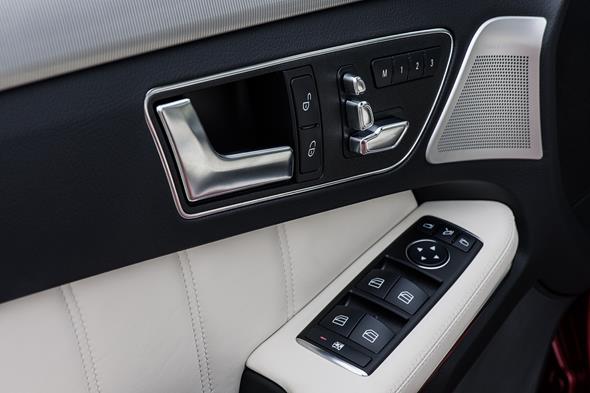
Also available are heated seats with three-stage adjustment via the controller and head unit display, as well as climatised seats for driver and front passenger offering active seat ventilation.
Generous rear seats
The spacious rear seats provide room for three occupants as standard in the form of a bench seat with three rear headrests, an armrest with stowage compartment and twin cup holder as well as ISOFIX child seat anchor points on the outer seats, with additional anchor points above on the rear seat backrest.
The following optional extras for the rear seats are also available for both the new E-Class Saloon and Estate:
- the Rear Seat Comfort package with two luxury individual seats in leather, NECK-PRO luxury head restraints, seat heating and Sun Protection package for exclusive, comfortable travel in the rear (not for Estate)
- the EASY-PACK Quickfold system, with rear seat backrests which fold in the ratio 1/3 to 2/3, and through-loading feature and also six load-securing points in the luggage compartment
- heated seats in the rear (in conjunction with leather appointments)
- rear seats with integrated child seats, including side headrest
- ski bag
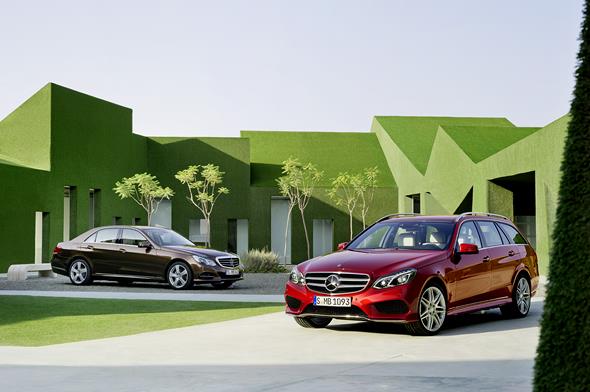
Individualisation
Unique freedom of choice
Individualisation with a capital “I” – this is one of the mottoes of the new E-Class. This is because the options for individual configuration have been significantly enhanced and are unique in this class.
As previously there are three lines to choose from, but in practice all of the equipment options remain available – irrespective of the chosen line (colours, fabrics, leathers, trim…).
As such each vehicle becomes totally individual: no one vehicle is like any other. For example one can opt for a classic look on the outside, but retain a totally modern look on the inside.

As ever, there are two attractive design packages to visually enhance both the interior and exterior of the E-Class. In addition to the basic appointments, there is also a choice of ELEGANCE and AVANTGARDE equipment lines – with the latter highlighting the sporty character of the Saloon and Estate models in particular.
Both lines differ from the standard version in respect of the following additional appointments:
- storage boxes underneath the front seats
- ambient lighting beneath the dashboard trim and the four door trim strips, individually adjustable in three colours (neutral, solar, polar)
- automatically dimming inside rear-view mirror
- illuminated stowage facilities in the centre console
- footwell lighting
- ambient lighting in the exterior mirrors
- the centre headrest in the rear can be lowered via a button in the centre console control panel
In addition, the AVANTGARDE line is is equipped with the DIRECT CONTROL suspension.
Furthermore, the equipment lines primarily differ from each other in terms of a number of design details in both the interior and the exterior. The following is a list of the most significant differences:
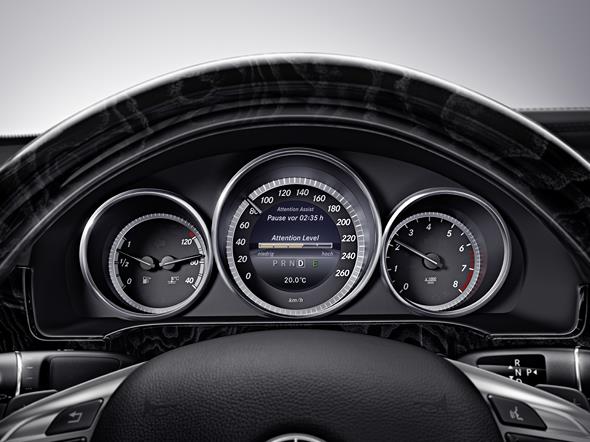
Standard equipment
Exterior
- radiator trim with three louvres in stone grey, front edge in chrome
- front bumper with sporty wing design, air intakes with black diamond grille, without chrome trim
- 16-inch 9-spoke light-alloy wheels
- No side chrome trim
- rear bumper which emphasizes the width, with insert in matt black plastic, without chrome trim
- concealed exhaust system
Interior
- multifunction steering wheel in nappa leather with four spokes
and two inserts in silver chrome - aluminium trim with light longitudinal grain, optional high-gloss brown eucalyptus wood trim
- air-conditioning control panel fascia in black plastic
- shift lever or DIRECT SELECT lever in nappa leather
- Strasbourg seat fabric with transverse stitching
ELEGANCE
Exterior
- radiator trim with three louvres in painted silver, front edge in chrome
- front bumper with sporty wing design, air intakes with black louvres, chrome trim on the outer air intakes and beneath the spoiler lip
- 17-inch multi-spoke light-alloy wheels (E 500 18-inch)
- chrome trim above the side skirts
- rear bumper which emphasizes the width, with insert in matt black plastic and chrome trim
- concealed exhaust system
Interior
- multifunction steering wheel in nappa leather with four spokes and two inserts in silver chrome
- high-gloss dark brown burr walnut wood trim
- air-conditioning control panel fascia in high-gloss dark brown burr walnut
- shift lever or DIRECT SELECT lever in nappa leather with insert in high-gloss dark brown burr walnut
- Strasbourg seat fabric with transverse stitching
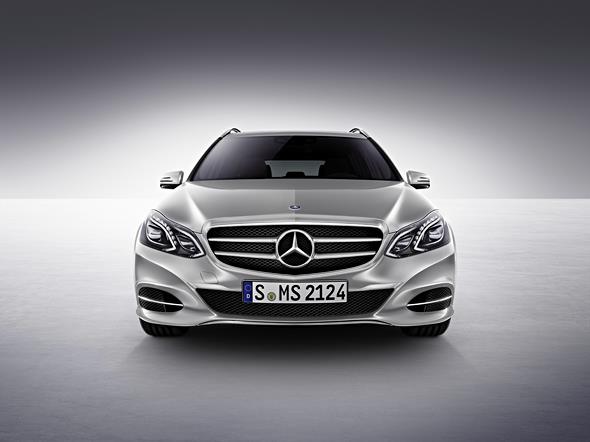
AVANTGARDE
Exterior
- soft nose clearly distinct from the bonnet, radiator trim with two louvres and central star
- front bumper with sporty wing design, air intakes with black diamond grille, chrome trim on the outer air intakes and beneath the spoiler lip
- 17-inch 5-twin-spoke light-alloy wheels with a high-sheen finish, or
18-inch 5-twin-spoke light-alloy wheels with a high-sheen finish - chrome trim above the side skirts
- sporty rear bumper, with insert in matt black plastic and chrome trim
- twin-pipe exhaust system with diamond-shaped tailpipe trim integrated into the bumper
Interior
- sporty three-spoke multifunction steering wheel as standard, finished in nappa leather with perforated inserts and thumb-rests, two silver-chrome inserts on the lower spoke
- aluminium trim with dark textured grain
- air-conditioning control panel fascia in aluminium with dark textured grain
- shift lever or DIRECT SELECT lever in nappa leather with insert in aluminium with dark textured grain
- seats in ARTICO man-made leather/Grenoble with transverse stitching
Equipment packages make individual choice easier
Three optional equipment packages provide additional options for differentiation and individualisation:
Exclusive package – adds value with high-quality appointments. It comprises:
- nappa leather upholstery for seats, centre armrest and door armrests and door centre panels
- roof lining, pillars and sunblind in DINAMICA microfibre
- dashboard and beltline in ARTICO man-made leather with topstitching
- velour floor mats with nubuck strip in appointments colour
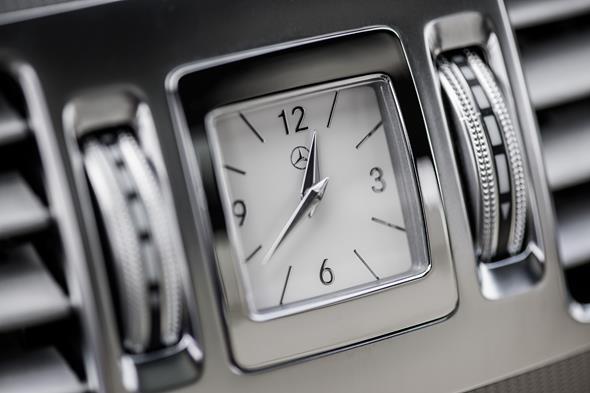
AMG Sports package – with AMG bodystyling and technology for a sporty appearance and enhanced driving dynamics. It comprises:
- AMG bodystyling consisting of a front and rear apron plus side sill panels
- 18-inch AMG 5-twin-spoke light-alloy wheels with 245/40 R 18 on
8.5 J x 18 ET48 (front), and 265/35 R 18 on 9 J x 18 ET54 (rear) - 18-inch AMG 5-twin-spoke light-alloy wheels with a high-sheen finish and 245/40 R 18 on 8.5 J x 18 ET48 for 4MATIC models
- larger brake discs on the front, perforated
- front brake callipers with “Mercedes-Benz” lettering
- DIRECT CONTROL sports suspension (not for 4MATIC models)
- twin-pipe exhaust system with rectangular, integrated tailpipe trim in polished stainless steel
- front sports seats with deeply contoured lateral support on the seat backrest
- ARTICO man-made leather/DINAMICA microfibre upholstery in black with light-coloured contrasting stitching (black leather upholstery optionally available)
- centre armrest and armrests in the doors in black with light-coloured contrasting stitching
- AMG sports steering wheel in black nappa leather featuring 3-spoke design and with flattened bottom section
- shift lever in nappa leather with chrome trim
- DIRECT SELECT shift paddles and manual shift mode (M) in conjunction with automatic transmission
- sports pedals in brushed stainless steel with rubber studs
- floor mats with AMG lettering
- roof lining in black fabric
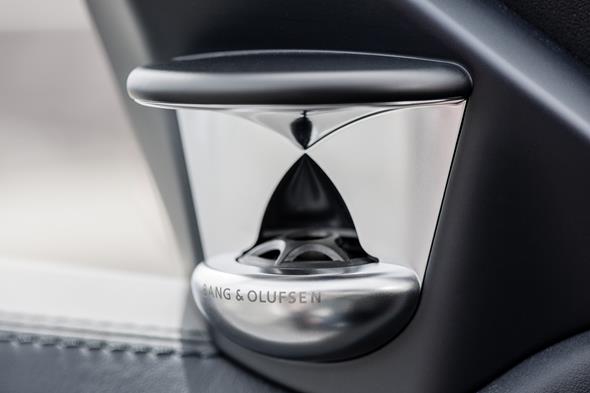
Exterior Sports package – enhances the exterior of the vehicle with an even sportier appearance and enables a more sporty and agile driving sensation. It comprises:
- 18-inch AMG 5-twin-spoke light-alloy wheels with 245/40 R 18 on
8.5 J x 18 ET48 (front), and 265/35 R 18 on 9 J x 18 ET54 (rear) - sports suspension (not for 4MATIC)
- larger, perforated front brake discs
- brake callipers with Mercedes lettering
- exhaust system with two rectangular, integrated tailpipes
Body
Focusing on quality and functionality
The body of the E-Class has already proven its exceptional qualities when it comes to safety and comfort. On top of this it offers outstanding aerodynamics and, thanks to innovative production and quality assurance processes, consistently high quality. These characteristics impressed 400 automotive experts in 2009 when they presented the body of the E-Class Saloon with the EuroCarBody Award.
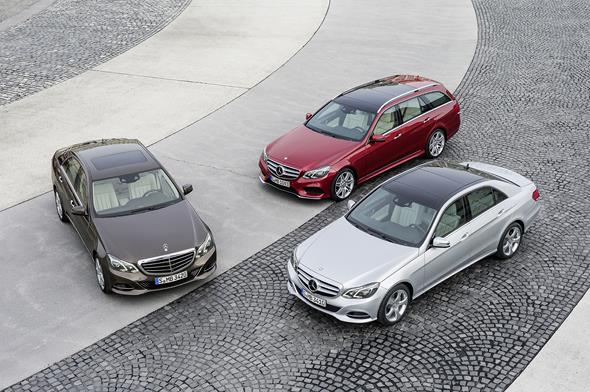
Since the basis of the body has not been changed, the new E-Class also boasts the same outstanding characteristics. These include:
- extremely stiff, rigid passenger cell made of highest grade and
- high-strength steels
- comprehensive deformation zones in the front and rear areas
- lightweight construction – bonnet, wings and boot lid (tailgate on the Estate) are made of aluminium
- high ease of repair thanks to removable front and rear modules
Also new are the headlamps featuring LED technology – optionally also even available as full LED variants. The advantages of LED technology include:
- long service life
- colour temperature similar to daylight
- energy efficiency, since LEDs require significantly less energy than halogen and xenon lights while offering the same level of light output
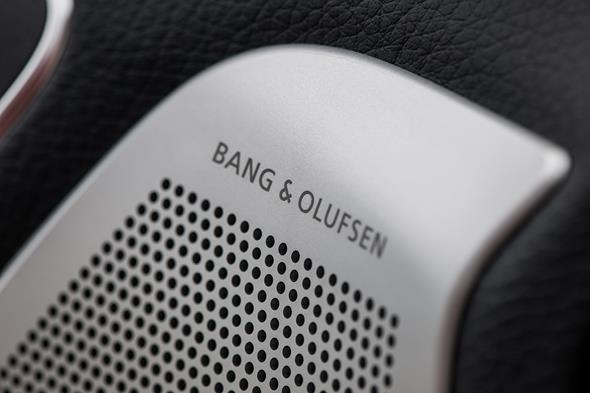
HANDS-FREE ACCESS for convenient loading
Also new: as an option the E-Class can be fitted with so-called HANDS-FREE ACCESS in conjunction with the KEYLESS-GO package. Its state-of-the-art technology enables the boot lid to be opened and closed without actual physical contact by simply holding your foot beneath the bumper – a significant increase in convenience when loading and unloading the vehicle.
The HANDS-FREE ACCESS feature also prevents hands from getting dirty and also luggage, since otherwise in the meantime one would have to place it down on the ground in order to open the boot.
The E-Class Saloon provides a spacious, illuminated boot. It has a volume of 540 litres, with space for four golf bags for example. The luggage compartment of the Estate is unrivalled in its spaciousness and sets the standard in this segment.
Behind the rear seat backrests a volume of 695 litres is available, and with the rear seat backrests folded down this becomes up to 1950 litres. HANDS-FREE ACCESS, EASY-PACK Quickfold with convenience feature or the EASY-PACK folding folding load compartment floor with EASY-PACK luggage compartment comfort box all help to enhance the convenience and usability of the luggage compartment.
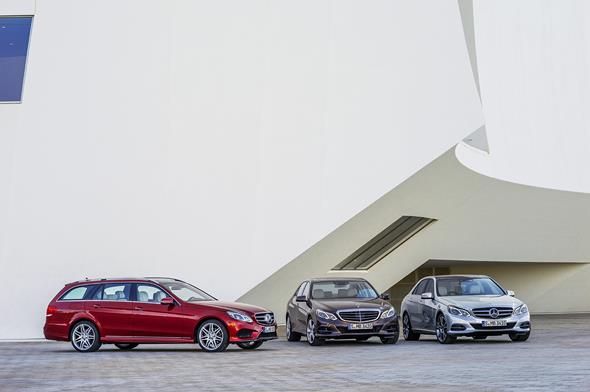
Consistent optimum values for aerodynamics and aeroacoustics
The outstanding aerodynamic qualities of the E-Class have also been retained following the design modifications implemented in the new E-Class. Both the Saloon (Cd value 0.26 – 0.28) and the Estate (Cd value 0.29 – 0.31) are at the top of their segment in this area too.
Excellent aeroacoustics effectively contribute to the typically high levels of ride comfort found in the E-Class. Even at high speeds, very little flow noise penetrates into the vehicle interior.
An additional increase in comfort can be achieved with the optionally available acoustic laminated safety glass for the sliding side windows in the front and rear. It creates even higher levels of noise comfort and at the same times affords more protection and safety against breakage.
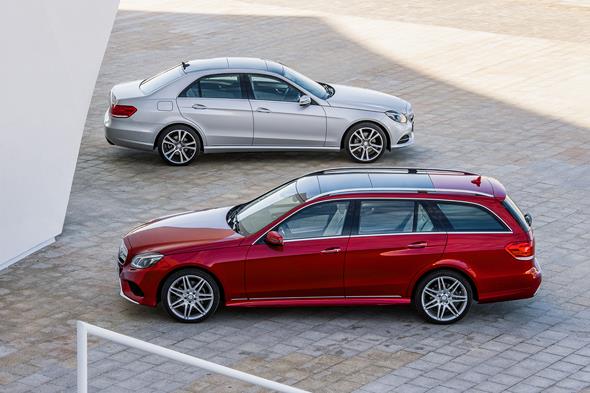
New level of safety
Intelligent assistance systems with a keener eye
What started with the PRE-SAFE® system some ten years ago and continued with DISTRONIC PLUS has resulted in a new dimension of motoring at Mercedes-Benz: comfort and safety are merged into one, opening up all sorts of new prospects for motorists and car developers alike.
Mercedes-Benz refers to this as “intelligent drive”. Optionally, the E-Class features a whole host of new or optimised systems on board which help to make motoring more comfortable and safer.
In the main markets, the Saloon and Estate models are fitted as standard with COLLISION PREVENTION ASSIST, a radar-based collision warning system with brake assist systems. It helps to significantly reduce the risk of a rear-end collision.
Also forming part of the standard equipment is ATTENTION ASSIST, which is now able to warn of inattentiveness and drowsiness across a wider speed range, and also inform the driver about his level of fatigue and the amount of driving time which has elapsed since the last break. It also offers an adjustable sensitivity level.
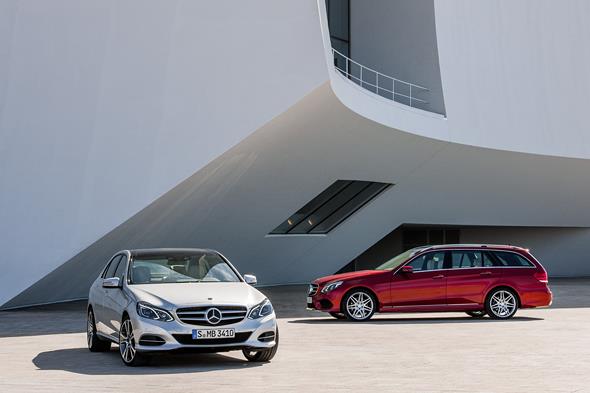
“The intelligent assistance systems of the future will be able to analyse complex situations and recognise potential dangers out on the road with the aid of improved environment sensor systems even more accurately than today,” explains Prof. Dr Thomas Weber, Member of the Daimler Board of Management responsible for Group Research and Head of Mercedes-Benz Cars Development. “Figuratively speaking, the new E-Class doesn’t just
have eyes at the front, it has 360-degree all-round vision.”
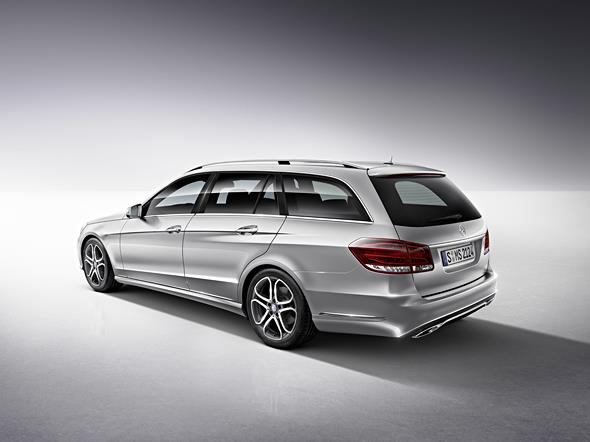
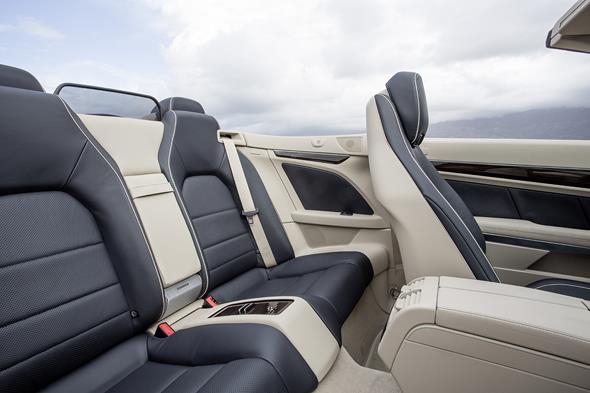
Of crucial importance in this respect is the networking of all systems, or “sensor fusion” as the safety experts call it. Mercedes-Benz is continually enhancing the performance capabilities of its assistance systems with the aim of ensuring comprehensive protection, not just for the occupants of a Mercedes-Benz, but for all other road users too.
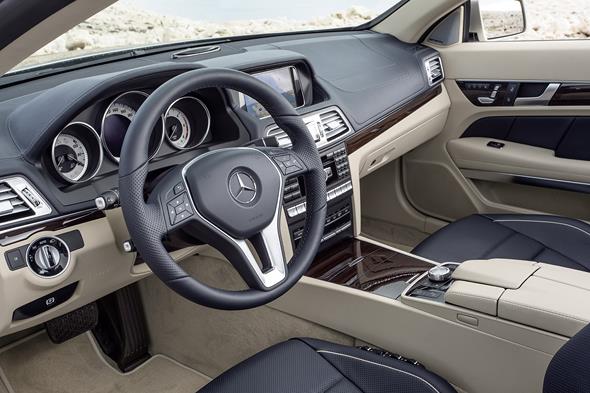
The new systems hold tremendous potential for either preventing accidents or mitigating their consequences according to Dr Weber: “Take, for instance, the new BAS PLUS assistance system with Junction Assist.
The results of our accident research based on the data from the GIDAS (German In-Depth Accident Study) indicate that it could reduce or prevent 27 percent of all accidents at road junctions resulting in personal injury. That equates to some 20,000 accidents a year in Germany alone.”
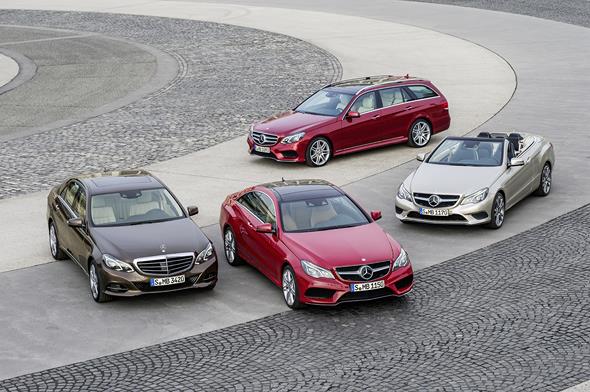
New sensors, new senses, new intelligence
The basis for the innovative functions comes courtesy of highly modern sensors and appropriately networked algorithms. Mercedes-Benz is making a major leap forward with the introduction of the Stereo Multi-Purpose Camera (SMPC), or stereo camera for short. Just like the Multi-Purpose Camera (MPC) fitted previously, it is positioned behind the windscreen in the vicinity of the rear-view mirror.
It has an aperture angle of 45 degrees and is capable of spatial detection of objects moving crossways ahead and also pedestrians, and calculating their path. The camera’s two “eyes” provide it with a three-dimensional view of the area up to approx. 50 metres in front of the vehicle, and it is able to monitor the overall situation ahead for a range of up to 500 metres. In this way, the new camera is able to provide data for processing by various systems.
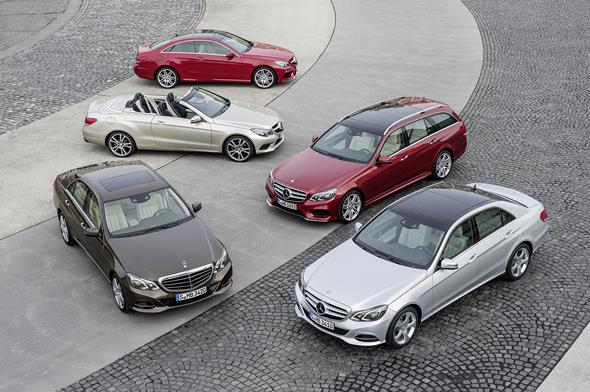
Intelligent algorithms evaluate this information in order to detect and carry out spatial classification of both vehicles that are driving ahead, oncoming or crossing, as well as pedestrians and a variety of traffic signs within a large field of vision.
Whereas the stereo camera’s lenses act as the car’s eyes, the radar sensors are its ears, so to speak, and provide additional data. The system of radar sensors comprises two short-range radar sensors in the front bumper with a range of 30 metres and a beam angle of 80 degrees, which are complemented by a long-range radar (200 metres, 18 degrees) including medium-range detection (60 metres, 60 degrees). The data from the camera and radars is amalgamated in a control unit in order to provide the system-specific data for the various functions.
Comfort-enhancing assistance with lateral lane guidance: DISTRONIC PLUS with Steering Assist
The DISTRONIC PLUS proximity control system is a driver aid designed to keep the vehicle at the desired distance from another vehicle in front that is travelling slower than the selected cruising speed. This basic radar-based function has now been enhanced by the addition of Steering Assist, which helps drivers to stay centred in their lane by generating the appropriate steering torque when travelling on a straight road and even on gentle bends.
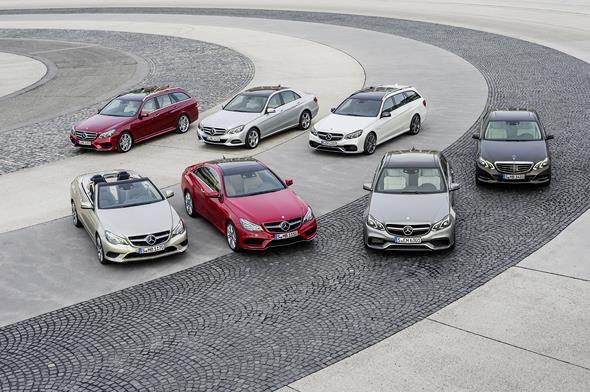
The stereo camera recognises lane markings as well as vehicles driving ahead together with their spatial positioning, and relays this information to the electric steering assistance system. When driving at slow speeds, e.g. in congested traffic, the Steering Assist can use the vehicle ahead as a means of orientation, enabling semi-autonomous tailback tracking even when there are no clear lane markings visible. As a result, the system is able to further boost driving comfort and substantially ease the driver’s workload in many traffic situations.
The new Steering Assist sub-function integrated into the DISTRONIC PLUS system is predominantly based on the new stereo camera. At the same time, the area in front of the vehicle continues to be monitored by two short-range radar sensors and a long-range radar sensor with medium-range detection.
The system fuses the data gleaned from both technologies, calculates any reactions required, and then regulates the vehicle’s linear speed as requirements dictate by controlling engine power, transmission and brakes, as well as actuating the electric steering for lateral vehicle guidance.
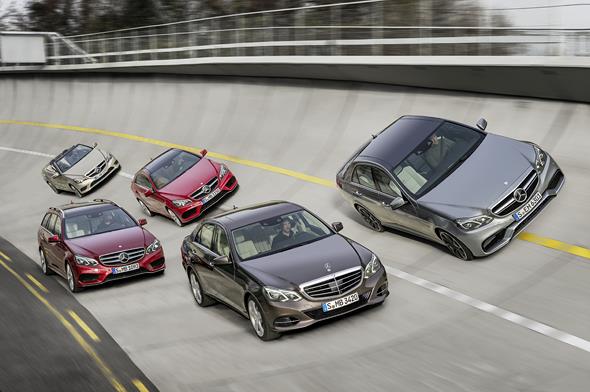
The DISTRONIC PLUS with Steering Assist can be activated as before with a selector lever on the steering wheel in a speed range from 0 – 200 km/h. Any speed between 30 km/h and 200 km/h can be selected as the desired cruising speed.
A green steering wheel symbol appears in the instrument cluster to indicate when the Steering Assist is operating while DISTRONIC PLUS is activated. Meanwhile, linear controlling actions (cruise control function) continue to be visualised in the speed display by means of circular segments and the speedometer needle.
Drivers must keep their hands on the steering wheel at all times even when Steering Assist is activated, as the function only works in bends above a certain, speed-dependent radius. Legal considerations also mean there are no plans to introduce hands-free driving.
The system’s design is so refined that the sensors can detect whether the driver’s hands are actually on the steering wheel. If they are not, a visual warning is issued first. Should the driver fail to react to this, a warning signal sounds and lateral lane guidance is deactivated. This does not affect the cruise control function, however, which continues to be operative.
Needless to say, the driver is able to override the Steering Assist at any time. If the driver signals to change lane, for instance, the lateral guidance function will switch into passive mode for the duration of the lane change.
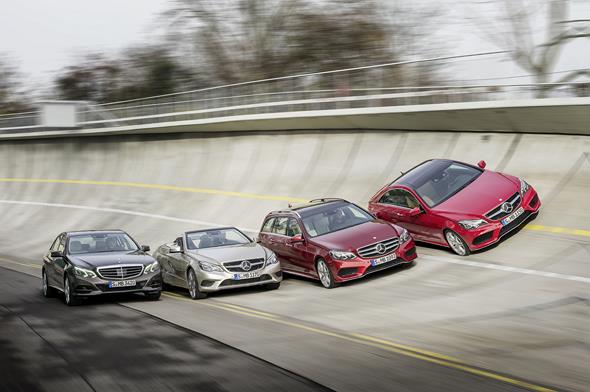
The performance capabilities of the basic DISTRONIC PLUS function have been increased once again. Now, the system is able to brake at a rate of up to 5 m/s² without any intervention from the driver. If the “S” drive mode button is pressed, the rate of acceleration increases, too. Vehicle acceleration is also far more dynamic if the driver signals a wish to overtake by switching on the indicators, assuming the road is clear.
By combining the radar and camera data, DISTRONIC PLUS is also able to detect both vehicles cutting in and vehicles ahead in adjacent lanes and take any necessary action promptly. This can prevent illegal undertaking on motorways and similar multi-lane highways, for example, by adapting the speed to that of vehicles in the outside lanes.
Braking assistance for cross traffic too: BAS PLUS with Junction Assist
Apart from material damage, accidents at junctions often result in serious personal injuries, too. The new Brake Assist BAS PLUS with Cross-Traffic Assist from Mercedes-Benz is therefore capable of more than just helping the driver to avoid collisions with vehicles ahead or lessen their consequences in a purely linear direction: the new Junction Assist function can also come to the driver’s aid when there is a risk of a collision with cross traffic at junctions.
If this anticipatory system detects a hazardous situation of this type, it prompts the driver to start emergency braking by activating visual and acoustic warnings. If the driver presses the brake pedal too tentatively, BAS PLUS will step in by automatically boosting brake pressure for effective emergency braking, even applying the brakes at full power if necessary. Applying just the right amount of braking power for the situation at hand maximises the available braking distance for traffic behind.
The Junction Assist function is operative at speeds up to around 72 km/h, while BAS PLUS is able to aid the driver in linear situations at any speed.
BAS PLUS with Junction Assist is potentially able to either prevent or lessen the severity of around 27 percent of all accidents at road junctions resulting in personal injury. This equates to some 20,000 accidents a year in Germany alone (source: investigations carried out by the GIDAS – German In-‑Depth Accident Study – and Mercedes-Benz Accident Research).
With pedestrian detection and city brake function: BAS PLUS and PRE-SAFE® Brake
Pedestrian detection has been added to the BAS PLUS and PRE-SAFE® Brake functions, while autonomous braking for vehicles in front has undergone a major enhancement too.
Thanks to the combination of stereo camera and radar sensors, it is now possible to detect pedestrians in front of the vehicle. Visual and acoustic warnings are triggered when a hazard is spotted.
If the driver then reacts by braking, the braking power will be boosted by BAS PLUS as the situation requires, right up to a full brake application. Should the driver fail to react, PRE-‑SAFE® Brake triggers autonomous vehicle braking. The PRE-SAFE® Brake with pedestrian detection is active up to approx. 72 km/h, and is able to prevent collisions with pedestrians autonomously from an initial speed of up to 50 km/h.
Evaluations of GIDAS accident data indicate that this new technology could avoid six percent of pedestrian accidents and reduce the severity of a further 41 percent. The operating range of the autonomous braking function for stationary vehicles has been optimised so that rear-end collisions can likewise be avoided at speeds of up to 50 km/h.
BAS PLUS with Junction Assist and the PRE-SAFE® Brake with pedestrian detection rely on the same sensors employed for the adaptive proximity control system DISTRONIC PLUS with Steering Assist: the new stereo camera plus the multistage radar sensor system.
Reacts to broken lines too: Active Lane Keeping Assist
The new improved version of the Active Lane Keeping Assist is now also able to intervene should the driver inadvertently cross a broken line when the neighbouring lane is not clear and this could result in the risk of a collision when changing lane.
The system can determine if this is the case using the information from the stereo camera and the radar system. The latter has been supplemented by a sensor at the rear, which works in unison with the other sensors in the front and rear bumpers.
The Active Lane Keeping Assist is not only capable of recognising critical situations such as overtaking vehicles, vehicles to be overtaken and parallel traffic, it can also respond effectively to oncoming traffic.
If the system detects the vehicle crossing the lane markings when the adjacent lane is not clear, not only does it cause the steering wheel to vibrate in pulses as a tactile warning for the driver, it guides the vehicle back into lane by applying a corrective braking force on one side via the ESP®.
It thereby forms the ideal complement to the Active Blind Spot Assist, and for the first time also enables the often fatal collisions with oncoming traffic to be avoided.
The Active Lane Keeping Assist is active at speeds between 60 and 200 km/h. If driver activity in the form of e.g. active steering, braking or acceleration is detected or when the indicators are switched on, both the warning and the corrective brake actuation are suppressed.
Now also identifies no-overtaking zones and no-entry signs: Traffic Sign Assist
A new Traffic Sign Assist which builds on the capabilities of the previous Speed Limit Assist represents yet another contribution to accident prevention from Mercedes-Benz. The system is now also able to recognise no-overtaking zones and alert drivers to no-entry restrictions.
The camera on the inside of the windscreen continues to pick up speed limit signs, including those on overhead gantries and in roadworks, for example. The camera’s data is cross-referenced against the information in the navigation system and can be displayed in both the instrument cluster and the map view.
If the camera fails to spot any road signs showing a speed limit or a speed limit is lifted, the legal speed limits based on the navigation data are shown instead, such as a maximum speed of 100 km/h on country roads in Germany or 50 km/h in built-up areas.
No-overtaking zones and the signs signalling their end are also registered and displayed, while in the case of signs imposing access restrictions, an acoustic warning is additionally emitted together with a visual warning in the instrument cluster – making an effective contribution towards helping to prevent serious accidents caused by wrong-way drivers.
Visualising drowsiness: ATTENTION ASSIST
A quarter of all motorway accidents in Germany are put down to drowsiness, making it one of the most frequent causes of accidents, most of which are of a serious nature. In 2009, Mercedes-Benz presented ATTENTION ASSIST, which is able to detect tell-tale signs of inattentiveness and increasing drowsiness based on changes in steering behaviour and a host of other factors.
The system has been subject to on-going development, and the latest version has the ability to detect drowsiness and inattentiveness across a far greater speed range from 60 – 200 km/h. Furthermore, the system’s sensitivity can be adjusted, e.g. for drivers who already feel tired when they get behind the wheel.
A new menu in the instrument cluster display also makes the system more tangible and transparent for the driver by visualising the current attention level and the driving time since the last break. What’s more, it is also possible to see whether the system is active in the current driving situation.
The system can be deactivated by making the appropriate selection in the instrument cluster menu. However, it will always be automatically reactivated with the sensitivity setting last selected the next time the vehicle is started.
Automatic manoeuvring into and out of parallel and end-on parking spaces: Active Parking Assist
The Active Parking Assist enables automated parking with active steering and brake control in both parallel and end-on spaces. It is an advanced version of the PARKTRONIC system with Parking Guidance offered previously. What’s more, the system is now also able to manoeuvre out of parallel parking spaces again all by itself with automatic steering and brake control, assuming the vehicle was parked there automatically previously.
When travelling at speeds below 30 km/h, ultrasonic sensors with an extended range in the bumpers’ side sections survey the nearside of the road for suitable parallel and end-on parking spaces. The same procedure is carried out for the far side of the road if the driver indicates accordingly. A symbol in the instrument cluster shows that the system is in the process of measuring. If a suitable parking spot is identified, an arrow appears alongside the symbol indicating that the system is ready for automatic parking. All the driver now has to do to activate the system is engage reverse gear and confirm by pressing the OK button on the steering wheel.
The Active Parking Assist steers and brakes the vehicle automatically as well as indicating the required driver actions in the display in each case, such as the transmission position to be selected. The driver moves the vehicle by lightly pressing the accelerator or releasing the brake.
Permanent high beam with no dazzling: Adaptive Highbeam Assist Plus
Around 20 percent of all road journeys in Germany are undertaken at night. But this is when some 40 percent of all accidents occur. A main cause for this is poor visibility. According to a study by the University of Michigan, high-beam headlamps can only be used during eight percent of driving time – which is nowhere near enough.
Based on this, it can be assumed that the time during which high-beam headlamps can be used in Germany is likely to be even lower given the denser amounts of road traffic compared with the USA.
For the first time, the Adaptive Highbeam Assist Plus allows the high-beam headlamps to be kept on permanently while driving by masking out any other road user detected in the beams’ cone of light. If the camera-based system registers either oncoming traffic or vehicles ahead, it will adapt the light distribution according to the specific situation when the high beam is switched on.
Consequently, the driver can simply leave the high-beam headlamps on at all times and use their full range without irritating or even endangering other road users. There is no need to switch them on and off manually, resulting in a significant increase in the overall driving time with high beam.
The Adaptive Highbeam Assist Plus likewise makes use of the new stereo camera also employed by other assistance systems. If its image recognition algorithm picks up a vehicle that is oncoming or driving ahead, it actuates a mechanism in the headlamp module.
This then masks the portion of the LED headlamp’s high-beam cone of light where there are other vehicles to prevent their drivers from being dazzled. If road users are detected outside the area that can be masked – for instance when cornering with multiple vehicles in the headlamps’ beams – the system will switch to the familiar system of headlamp range control using the low-beam headlamps.
Possible backglare caused by increased use of the high beam and highly reflective signs at the side of the road is also detected and eliminated by dimming the headlamps accordingly.
The Adaptive Highbeam Assist Plus builds on the Adaptive Highbeam Assist system first introduced by Mercedes-Benz in 2009. If this system detects oncoming traffic or traffic driving ahead with the help of a camera, it dips the headlamps and automatically adapts the low beam’s range according to the situation.
In this way, it allows the road to be illuminated for a long way ahead without dazzling other drivers. In addition to this, adaptive control of the low-beam headlamp range with smooth transitions results in gentler lighting changes that the eyes can quickly adjust to.
At a glance
The main new functions of Mercedes-Benz assistance systems
Trend-setting safety
Airbags, restraint systems and pedestrian protection
Innovative driver assistance systems, preventive protective measures,
a stress-resistant body structure and highly effective restraint systems make the E-Class one of the safest vehicles in its segment.
The basis for this is the integrated safety concept from Mercedes-Benz, which combines all elements of active and passive safety in a well-thought-out system – providing protection to the vehicle occupants and other road users. The integrated safety concept meets, to an unprecedented extent, the requirements for a high degree of vehicle and road safety, and is oriented towards real-world accidents.
PRE-SAFE® PLUS: occupant protection in an impending rear-end collision
Mercedes-Benz has extended the well-known PRE-SAFE® preventive occupant protection system to cover dangerous situations caused by traffic following behind.
A radar sensor in the rear bumper monitors the traffic behind the vehicle and can detect an impending rear-end collision. The system alerts the driver of the vehicle behind to a dangerous situation by quickly flashing the rear hazard lights (not for the USA and Canada). In addition, it triggers the preventive
PRE-SAFE® occupant protection measures, which include reversible belt tensioners and active NECK-PRO® head restraints.
If the vehicle is stationary, PRE-SAFE® PLUS will keep it firmly braked, thus reducing any forward jolt. This can greatly reduce the strain placed on the occupants and the risk of whiplash injuries, for example. Firmly applying the vehicle’s brakes can help to prevent secondary accidents too, such as running into a vehicle in front, for example, or colliding with pedestrians or other road users at junctions.
State-of-the-art restraint systems
In the event of an accident, the best possible protection is provided by the restraint systems, the comprehensive deployment of airbags and the structural safety of the body. An innovative sensor system triggers the safety systems depending on the situation and coordinates them all with each other.
Restraint systems are the backbone of passive safety.
- 3-point seat belts for driver and front passenger with electronic, reversible belt tensioners in the PRE-SAFE® phase and pyrotechnic belt tensioners in the event of an accident as well as belt force limiters.
- 3-point seat belts on the outer seats in the rear with pyrotechnic belt tensioners, belt force limiters for all rear seats and rear belt status display in the instrument cluster. Making up part of the optionally available Rear Seat Safety package are 3-point seat belts with self-adaptive belt force limiters on the outer rear seats, which are able to adjust the belt force for small passengers and children in particular.
- NECK-PRO head restraints for driver and front passenger which provide early support for the head in the event of a rear-end collision and as such are able to reduce the risk of whiplash.
- ISOFIX child seat anchor points on the outer rear seats for the safe attachment of appropriate child seats with additional respective anchor point above on the rear seat backrest.
Also fitted on board the E-Class is an elaborate system of airbags:
- adaptive airbags for driver and front passenger with multistage deployment, depending on the detected severity of the impact
- sidebags for driver and front passenger, which are able to provide additional protection in the event of a side impact
- pelvisbags for driver and front passenger, which are able to protect the pelvic area in the event of a side impact
- windowbags between the A, B and C-pillars, to protect the head area of the driver, front passenger and passengers seated on the outer rear seats
- kneebags, which in specific types of impact can protect the driver in the area of the dashboard which comes into contact with the knees, and also stabilise the entire upper body by positively influencing occupant movement in the event of an impact
- sidebags in the rear provide additional protection for passengers on the outer rear seats; they are part of the Rear Seat Safety package which is available as an optional extra
Also making a contribution to safety is automatic child seat recognition (ACSR). It can deactivate the airbag on the front passenger side when a child seat with a corresponding transponder is fitted.
Consistent pedestrian protection
The E-Class also plays an exemplary role when it comes to pedestrian protection. The following measures are implemented for pedestrian protection:
- active bonnet, which is moved upwards by 50 mm when an impact is detected, thus creating additional deformation space during the impact; the system is reversible and can be reset by the driver, without having to visit the workshop, to enable him to continue driving
- BAS PLUS warns when pedestrians are detected in the danger zone by the Stereo Multi-Purpose Camera. The PRE-SAFE® Brake with pedestrian protection triggers autonomous braking when the system detects a pedestrian in the danger zone and the driver is not reacting to the system’s warnings. This pedestrian detection, in conjunction with the optionally available Driver Assistance package Plus, represents a milestone in preventing accidents with pedestrians and/or reducing their consequences.
Engine and drive system
Superior performance, economical consumption
“E” for “Efficiency”: this is the well-proven success formula with which the E-Class is raising the bar and showing how the intelligent interaction between technical innovations throughout the drive train can reduce fuel consumption.
The E-Class Saloon and Estate are available with a broad range of powerful and efficient petrol and diesel engines with optimised drive train. All are fitted with the ECO start/stop system.
The petrol engines: powerful, fast and clean
The BlueDIRECT petrol engines from Mercedes-Benz, which to date have comprised the familiar V6 and V8 engines, are characterised by the latest technology. A new addition is a six-cylinder engine which is being offered for the first time in the E-Class not only as a naturally aspirated engine, but also as the E 400 with a displacement reduced to three litres but also with a biturbo drive as a result. With its output potential and enormously high torque at low engine speeds, this six-cylinder model sets new standards in its segment. It produces 20 kW more compared with the E 350. Its torque has increased by 110 Nm and remains available in the engine speed range of 1600 to 4000 rpm. On top of this, the new, efficient six-cylinder engine also fulfils the EU6 emissions standard. The E 500 is making a name for itself as the most economical model in the V8 segment.
Another new addition to the BlueDIRECT petrol engine family is a four-cylinder petrol engine. With a combined fuel consumption in the E 250 of 5.8 litres
(135 g CO2 per km) and producing 155 kW (211 hp) from a displacement of just two litres, as well as 350 Nm of torque across a wide range of 1200 to
4000 rpm, it sets new standards in the four-cylinder segment. Providing acceleration from 0 to 100 km/h in 7.4 s (Estate 7.8 s), it provides the E-Class with spirited performance.
Lean burn process with stratified charge operation
Depending on the operating conditions, the new four-cylinder engine features stratified charge or homogenous operation. With stratified charge operation, the high-compression engine runs with significant excess air. To achieve this, the fuel is only sprayed into the air, which has already been compressed by the pistons, during the compression phase. A precisely controlled electronic multiple injection system helps to ensure that a fuel/air cloud builds up in a limited area around the spark plug, precisely at the time of ignition. This lights the ignitable fuel/air mixture around the spark plug, whereas only a very lean mixture with high excess air is to be found in the remainder of the combustion chamber. This enables extremely efficient combustion.
A prerequisite for stratified charge operation is fast piezo injectors. They spray the fuel into the combustion chambers several times in succession per power stroke, and as such enable specific control of the mixture formation and thus the flammability.
The new four-cylinder petrol engine from Mercedes-Benz also sees the world’s first use of this stratified lean burn process in combination with exhaust-gas turbocharging and external high-pressure exhaust gas recirculation. As a result the E 250 achieves a combined optimum consumption figure of 5.8 litres per 100 km (corresponding to 135 g of CO2/km), and is therefore the only vehicle in this segment to achieve efficiency class A. In addition, the new BlueDIRECT four-cylinder petrol engines already meet the EU6 emissions standard which will apply from 2015. The new four-cylinder engine also
meets the EU6 emissions standard in the guise of the homogenous variant
for countries with different fuel qualities.
Advanced technology makes engines more efficient
The BlueDIRECT four-cylinder petrol engines in the E-Class combine spontaneous response and exemplary power delivery with high efficiency
and best-in-class emission performance. To achieve this goal, Mercedes-Benz transferred the BlueDIRECT technology from the V6 and V8 engines into the four-cylinder models. Direct petrol injection with spray-guided combustion, which Mercedes-Benz was the first car manufacturer to introduce in series production, has been developed further by the engineers into third-generation direct petrol injection with spray-guided combustion. The system pressure is now up to 200 bar and is variably optimised according to the engine’s characteristic map. Completely newly developed piezo injectors allow up to
five injections per power stroke for the best possible mixture formation.
The third-generation direct injection system also features “rapid multi-spark ignition” (MSI). Following the first spark discharge and a brief combustion period, the coil is quickly recharged and a further spark is discharged. The MSI system enables up to four sparks to be discharged in succession within one millisecond, creating a plasma with a larger spatial expansion than conventional ignition.
The rapid multi-spark ignition can be actuated to vary both the timing of the sparks and the combustion period to suit the relevant operating point. This provides scope for the best possible centre of combustion and improved residual gas compatibility. This in turn reduces fuel consumption. The result
of this is excellent utilisation of the fuel with minimum emissions.
In conjunction with continuous adjustment of the intake and exhaust camshaft, the direct injection system also provides the essential basis for so-called scavenging. As a result of a partial overlap of the opening times of the intake and exhaust valve, part of the drawn-in cold fresh air conveys the hot exhaust gas contained in the cylinder into the exhaust manifold, thereby improving
the filling level substantially in comparison with the conventional mode of operation. Due to the increased mass flow in the exhaust line, the turbocharger additionally responds considerably faster at low revs in particular, avoiding turbo lag.
A new thermal management system has also been developed: in a cold state, a switchable water pump with flow-optimised ball valve ensures that no coolant flows through the engine, providing for swift heating-up of the combustion chambers after starting up the engine. The thermostat is electronically controlled and the coolant temperatures are adjusted according to driving style and ambient conditions. The thermostat itself is also a flow-optimised ball valve. In the interest of high efficiency, the volumetric flow of the oil pump is also controlled as in the V engines.
All engine variants are designed for operation with E10 premium petrol and
an octane number of 95 RON.
The petrol engines
| Model | Cylinders | Displacementcc | Output at rpm | Torque at rpm | 0-100 km/h in s | l/100 km | CO2g/km | EU | Efficiency class |
| E 200 | 4 | 1991 | 135 kW (184 hp)/5500 | 300 Nm/1200 – 4000 | 7.9(8.3) | 5.8(6.0) | 135(139) | 6 | B |
| E 250 | 4 | 1991 | 155 kW (211 hp)/5500 | 350 Nm/1200 – 4000 | 7.4(7.8) | 5.8(6.1) | 135(141) | 6 | A |
| E 300 | V6 | 3498 | 185 kW (252 hp)/6500 | 340 Nm/3500 – 4500 | 7.1(7.5) | 6.8(7.1) | 159(165) | 5 | C |
| E 300 4MATIC | V6 | 3498 | 185 kW (252 hp)/6500 | 340 Nm/3500 – 4500 | 7.4(7.8) | 7.4(7.8) | 174(184) | 5 | C |
| E 400 * | V6 | 2996 | 245 kW (333 hp)/5250 – 6000 | 480 Nm/1600 – 4000 | 5.3(5.4) | 7.5(7.9) | 175(183) | 6 | C |
| E 400 4MATIC * | V6 | 2996 | 245 kW (333 hp)/5250 – 6000 | 480 Nm/1600 – 4000 | 5.3(5.4) | 8.1(8.5) | 189(197) | 6 | D |
| E 500 | V8 | 4663 | 300 kW (408 hp)/5000 – 5750 | 600 Nm/1600 – 4750 | 4.9(5.0) | 8.9(9.3) | 209(216) | 5 | E |
| E 500 4MATIC | V8 | 4663 | 300 kW (408 hp)/5000 – 5750 | 600 Nm/1600 – 4750 | 4.8(4.9) | 9.4(9.5) | 219(222) | 5 | E |
All figures based on 7G-TRONIC PLUS (figures in brackets apply to Estate), * = provisional figures
In September 2013, the E 200 Natural Gas Drive with bivalent natural gas drive will complete the comprehensively updated range of drives for the
E-Class. The 120 kW (163 hp) four-cylinder engine in this Saloon model
can be run both on premium petrol and natural gas.
Powerful diesel engines in the best efficiency class
Some of the diesel models of the E-Class are available as BlueTEC models fitted with the established SCR (selective catalytic reduction) technology and as such meet the EU6 emissions standard.
The engine range is supplemented with the E 300 BlueTEC HYBRID. It combines the four-cylinder diesel engine (150 kW/204 hp) with an electric motor (20 kW/27 hp). The E 300 BlueTEC HYBRID consumes 4.1 l/100 km and produces CO2 emissions of 107 g/km. As such it occupies the leading position among the most economical models in the upper medium-size category.
The diesel engines
| Model | Cylinders | Displacementcc | Output at rpm | Torque at rpm | 0-100 km/h in s | l/100 km | CO2g/km | EU | Efficiency class |
| E 200 CDI | 4 | 2143 | 100 kW (136 hp)/2800 – 4600 | 360 Nm/1600 – 2600 | 9.5(10.1) | 4.9(5.3) | 127(137) | 5 | A |
| E 220 CDI | 4 | 2143 | 125 kW (170 hp)/3000 – 4200 | 400 Nm/1400 – 2800 | 8.4(8.6) | 4.7(5.2) | 125(134) | 5 | A |
| E 220 CDI Edition | 4 | 2143 | 125 kW (170 hp)/3000 – 4200 | 400 Nm/1400 – 2800 | 8.7 | 4.5 | 119 | 5 | A |
| E 250 CDI | 4 | 2143 | 150 kW (204 hp)/3800 | 500 Nm/1600 – 1800 | 7.5(7.8) | 4.8(5.2) | 128(136) | 5 | A |
| E 250 CDI 4MATIC | 4 | 2143 | 150 kW (204 hp)/388 | 500 Nm/1600 – 1800 | 7.9(8.1) | 5.5(5.8) | 143(152) | 5 | A |
| E 300 BlueTEC | V6 | 2987 | 170 kW (231 hp)/3800 | 540 Nm/1550 – 2400 | 7.1(7.4) | 5.5(5.7) | 144(152) | 6 | A |
| E 350 BlueTEC | V6 | 2987 | 185 kW (252 hp)/3600 | 620 Nm/1600 – 2400 | 6.6(6.9) | 5.5(5.7) | 144(152) | 6 | A |
| E 350 BlueTEC 4MATIC | V6 | 2987 | 185 kW (252 hp)/3600 | 620 Nm/1600 – 2400 | 6.7(7.0) | 6.0(6.4) | 160(170) | 6 | B |
| E 300 BlueTEC HYBRID | 4 | 2143 | 150 kW (204 hp)/4200Electric motor20 kW (27 hp) | 500 Nm/1600 – 1800Electric motor250 Nm | 7.5(7.8) | 4.1(4.4) | 107(116) | 5 | A+ |
All figures based on 7G-TRONIC PLUS (figures in brackets apply to Estate)
ECO start/stop function with direct-start
The ECO start/stop system included as standard in all models operates with the starter-supported ECO start/stop function. This means that when the engine is switched off, the attitude of the crankshaft is registered by a novel crankshaft sensor so that the engine control unit knows the positions of the individual cylinders. On restarting, it can then select the cylinder that is in the most suitable position for first ignition. After the starter has briefly turned over the engine, reliable injection, ignition and combustion are immediately possible in the ideally positioned cylinder.
Optimised drive train
Mercedes-Benz will also offer two transmissions for the E-Class in the future: a 6-speed manual transmission with high ease of shifting and short shift travel, and the 7G-TRONIC PLUS automatic transmission with DIRECT SELECT lever and DIRECT SELECT shift paddles. The features of the latest evolutionary stage of 7G-TRONIC PLUS include a new torque converter with reduced slip, an ECO shift programme with an improved ratio spread and an auxiliary oil pump to maintain the operating pressure during automatic stops. Low-friction components and low-viscosity fluid help to reduce the operating pressure.
A new feature is the short-term M mode. The benefit of this: if the driver has shifted up or down manually, after a set period of time the transmission independently switches back to automatic, fuel-efficient shift mode. This set period of time is lengthened in specific conditions (no accelerator pedal use, e.g. on downhill gradients, high lateral acceleration, e.g. when cornering, or if falling below a minimum speed when coming to a standstill), and return to automatic mode is prevented.
In short-term M mode as well as in “fixed” M Mode, the driver receives prospective gear change recommendations in the multifunction display
of the instrument cluster, to enable an efficient driving style.
4MATIC all-wheel drive
Traction and driving stability can also be improved in the E-Class with the 4MATIC all-wheel drive system – particularly in difficult road conditions. As ever, the combination of the ESP® vehicle dynamics control system with the 4ETS electronic traction system makes regular differential locks superfluous. This saves weight and noticeably increases driving safety as well as ride comfort. The transfer case of the all-wheel drive is integrated into the main transmission.
The all-wheel drive models impress with:
- good traction characteristics, with a power distribution ratio on the front and rear axles of 45:55
- low fuel consumption due to the improved efficiency of the drive train
- good noise and vibration characteristics
- additional weight of only 70 kg, compared with additional weight of up to 120 kg in the case of the competition
- unchanged bodyshell as well as unrestricted interior and luggage compartment space due to the compact design
The following engines are available with 4MATIC:
• E 250 CDI 4MATIC, 150 kW (204 hp), 500 Nm
• E 350 BlueTEC 4MATIC, 195 kW (265 hp), 620 Nm
• E 300 4MATIC, 185 kW (252 hp), 340 Nm
• E 400 4MATIC, 225 kW (306 hp), 370 Nm
• E 500 4MATIC, 300 kW (408 hp), 600 Nm
Chassis and suspension
The basis for superior handling
All of the models of the E-Class family will in future be fitted with an electromechanical Direct-Steer system as standard. This combines the speed-dependent power assistance of speed-sensitive steering with a variable ratio across the steering angle range. The power steering assistance provided by
the rack and pinion steering gear is controlled on-demand and therefore contributes towards efficiency.
Advantages of the electromechanical Direct-Steer system:
- improved agility thanks to more direct steering response
- comfortable handling and high levels of steering comfort across all speed ranges
- considerable savings potential, since energy is only required when steering occurs
- enables the use of innovative assistance systems, such as Active Parking Assist
Four suspensions to choose from
For the E-Class, Mercedes-Benz is offering four refined suspension configurations:
- the standard model and ELEGANCE line are fitted with the DIRECT CONTROL suspension with selective damping system, configured for comfort
- the sportily configured DIRECT CONTROL suspension with selective damping system is positioned 15 mm lower and part of the AVANTGARDE line
- the DIRECT CONTROL lowered sports suspension is available in conjunction with the Exterior Sports package and AMG Sports package
- The AIRMATIC air suspension with electronically controlled damping system is fitted as standard on the V8 models. The Estate is fitted as a matter of course with rear-axle air suspension with integrated level control.
On the front axle, the established 3-link front suspension helps to ensure optimum driving dynamics. Both of the links (torque strut and cross strut) in the lower link plane determine the comfortable characteristics of the axle. The third link, the tie rod, forms part of the rack-and-pinion steering system.
At the rear is the familiar multi-link independent rear suspension, featuring a lightweight design. It provides good wheel control qualities for high levels of comfort and excellent driving dynamics.
All suspension variants feature impressive sensitivity and ride characteristics and help to ensure a high level of handling safety.
Excellent braking with ADAPTIVE BRAKE
The brake system in the E-Class is fitted with the ADAPTIVE BRAKE as standard. Depending on the engine variant, the following braking systems are used on the front axle with internally ventilated brake discs:
- 1-piston floating brake callipers with different sized brake discs
for the 4-cylinder and V6 engine variants - 4-piston floating brake callipers for the V8 engine variants
On the rear axle, the E-Class is braked by 1-piston floating brake callipers with different sized brake discs. In the case of the V6 and V8 engine variants, the brake discs are internally ventilated.
All of the engines have a foot-operated parking brake with integrated, automatic cable adjustment. The force applied by the driver is distributed to two additional drum brakes on the rear axle via the brake cable in the centre tunnel. Automatic adjustment helps to reduce the servicing costs.
Infotainment
Navigation, internet connection and media player
A modern range of infotainment systems helps to keep the driver up to date while on the road in terms of what is happening around the world
or in the office. The systems also enable music to be enjoyed or also optionally offer powerful navigation solutions as well as an internet connection.
The E-Class Saloon and Estate both come as standard with the Audio 20 CD Radio. It features a twin tuner and mp3-capable CD player as well as a USB connection in the centre armrest. The TFT colour display measures 14.7 cm diagonally. Bluetooth®-capable devices can also be connected, and SMS text messages displayed. Thanks to a “cover art” function, the title images of the music albums currently being played are also shown if their details are stored in the audio file.
Optionally the Audio 20 CD can be combined with a six-disc CD changer as well as the reasonably-priced, entry-level Becker® MAP PILOT navigation solution, which can also be retrofitted. Its advantages over aftermarket solutions include integrated operation via the central controls, voice output via the vehicle’s loudspeakers and display on the Audio 20 screen, a concealed location in the glove compartment and updating via an internet portal.
With internet connection, navigation and emergency call function: COMAND Online
Alternatively, Mercedes-Benz offers the COMAND Online multimedia system for the E-Class with 17.8 cm high-resolution colour display, internet connection, hard-disc navigation and emergency call feature, which can also be combined with a six-disc DVD changer. COMAND Online provides internet access enabling customers to surf the web while the car is stationary or
call up a Mercedes-Benz app, whose particularly fast page loading and simple operation make it suitable for use while driving. Integrated apps include Google™ Local Search and Weather, Google™ Streetview as well as Google™ Panoramio. In addition, all COMAND Online users have access to a Facebook app.
COMAND Online is operated via what is known as a “COMAND Controller”, located close to the armrest on the centre console. This is the ergonomic position for it, allowing safe operation. The Controller is a high-quality rotary push-button with a galvanised finish, and can be moved intuitively in eight directions. Functions can also be activated or confirmed by turning and pressing it. A user-friendly new control logic for the main menus as well as for the sub-menus, which open up step by step, enables drivers to leaf through the menus safely and in a targeted manner.
COMAND Online comprises the following features:
- FM radio twin tuner with phase diversity and an additional RDS/TMC tuner for traffic information
- entry-level 4 x 25 W audio signal amplifier
- DVD drive for audio and video
- internet access
- integral navigation system with map display (including birdview
and a 3D map) - integrated hard disc for navigation data and additional functions
(e.g. music server) - the LINGUATRONIC voice-operated control system
In addition, COMAND Online also supports the following components:
- sound amplifier
- Media Interface
- DAB receiver (Digital Audio Broadcast)
- TV receiver
The fast hard-disc navigation system of COMAND Online also has added functions. New features include a 3D display with three-dimensional city views. Also new: routes covered can be recorded and repeated later, specific personal destinations can be stored or imported via an SD card. Mercedes-Benz customers in Europe receive the current maps for their COMAND Online multimedia system free of charge for three years.
COMAND Online also includes the LINGUATRONIC voice-operated control system for audio, telephone and navigation. The new “One Shot” input function for the navigation system is particularly convenient, whereby the place and road can be spoken directly after one another. This function is currently available in seven languages and significantly enhances ease of operation. With COMAND Online and LINGUATRONIC, music can also be conveniently searched for in the E-Class via voice control. The system first asks in which category it should conduct the search (artist, title, year). The category is selected by saying it directly or by saying the row number of the relevant category which appears on the screen. This is then followed by further questions about title, artist or album.
New apps for COMAND Online
The range of apps is being constantly expanded: currently there is already a free news app and a Yelp app (in the US version only), and apps for share prices and a car park finder.
- With the news app, the user is always up-to-date with what’s happening in the world. Sorted according to categories such as financial or sports news, it always finds the latest news bulletins.
They are presented in such a way that they are also easy to read whilst driving too.
- The Yelp app (in the US version only) enables users to search for restaurants from their vehicle, using the social database filled by the Yelp Community. The Yelp app offers a choice according to various restaurant categories, within which it is possible to search for recommendations close to the current position, at the destination point programmed into the navigation system, or at any other specific location.
- The app which searches for car parks calls up the current occupancy of multi-storey car parks in real time, as well as other information such as opening times and charges. The app supplies data in Germany, Austria and Switzerland. Once a suitable parking opportunity has been found, the driver can start the navigation to that destination or call the telephone number provided.
Music to suit your personal taste
Where the audio equipment is concerned, too, new types of representation bring a fresh look and more convenient operation. The so-called Cover Flow function, for instance, sorts the title images of the music albums stored in a carousel-like form, so that the driver can leaf through their music collection. The memory for compressed audio files (mp3, wma and aac formats) is now
10 GB in size.
Greatest convenience is afforded by the Music Search function, which enables drivers and passengers to search the hard disc, SD memory cards, USB sticks, CDs and DVDs for specific music tracks and artists. The search can be according to various criteria, for instance album, music category or composer. If a name needs to be entered, the software will also tolerate spelling mistakes. The driver is therefore able to devote their full attention to the traffic. As a further advantage, the occupants are able to search all the connected media and devices simultaneously.
SPLITVIEW – one screen, two programmes
A further highlight of the E-Class is the optionally available screen featuring SPLITVIEW technology, which allows the driver and front passenger to view two different sets of content at the same time. While the driver is checking the navigation instructions, the front passenger can sit back and watch a film on the very same display.
Developed by Mercedes-Benz and Bosch, SPLITVIEW technology makes use of a backlit active matrix colour display (TFT-LCD). This shows two different images simultaneously by placing pixels adjacent to each other. A filter masking the display divides this mixed image in such a way that depending on the seating position, only the pixels making up one or the other image can be seen. As a result, the driver and front passenger can view different programmes on the same screen at the same time.
So as not to distract the driver, a remote control is available for the front passenger. In addition, he can enjoy his personal entertainment programme using headphones. Of course, the front passenger need not dispense with making use of telephone or navigation features, since he is also able to use the display to access all of the information from the COMAND Online control and display system.
Mercedes-Benz emergency call system: emergency services are notified automatically
The Mercedes-Benz emergency call system is also included in combination with the COMAND Online multimedia system available for the E-Class. As long as COMAND Online is connected to a mobile phone, the emergency call system can automatically alert the emergency services within a matter of minutes in the event of a serious accident.
After the airbags or belt tensioners are triggered, the vehicle’s exact GPS position and vehicle identification number (VIN) are sent by SMS to a special emergency centre, with positional data also being transmitted using the DTMF method (dual-tone multi-frequency) at the same time. Even if the occupants are unconscious or unsure of exactly where they are because they are on a holiday trip, for example, the emergency services alerted by the emergency centre will be notified quickly with accurate information. The driver can also make the emergency call manually as “MB emergency call” is always the first entry in the system phone directory.
On receiving the call, the emergency centre establishes voice contact with the vehicle occupants in a matter of seconds. A particularly practical aspect in an emergency is that communication takes place not in the language of the country where the accident has occurred but in the language which the driver has preset in COMAND Online.
Other than any mobile phone communication charges, which would only arise in the event of an actual emergency call, no charges are incurred for the emergency call facility and no contractual relationship – other than the regular mobile phone contract – is required.

